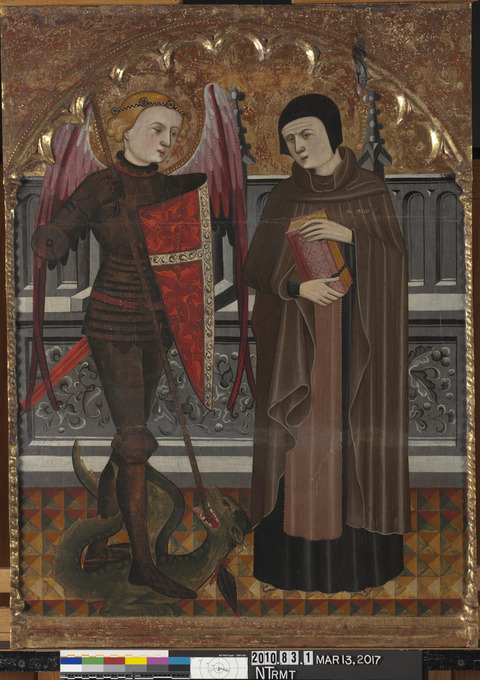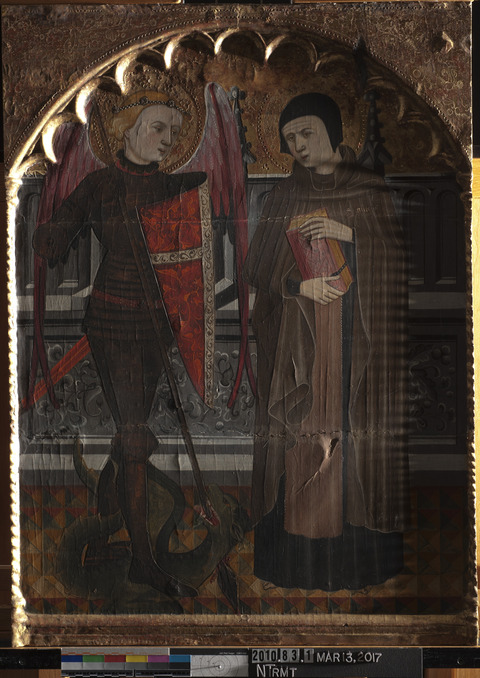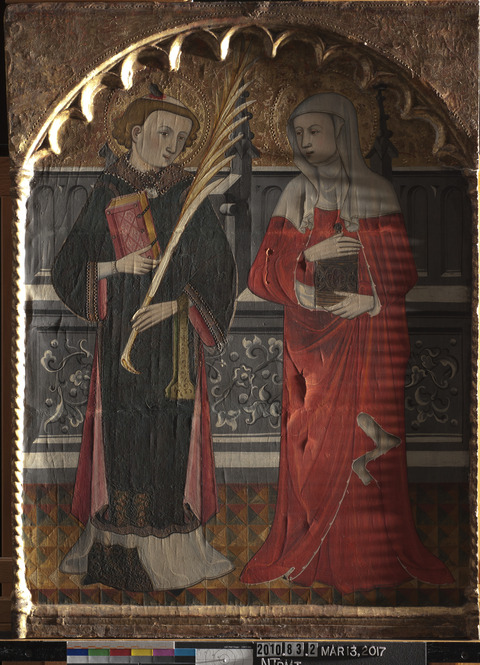Overview
Accession numbers: 2014.83.1, 2014.83.2
Artist: Pere Vall
Titles: St. Michael and St. Amador; St. Stephen and St. Mary Magdalene
Materials: Egg tempera, oil [confirmed], and gilding on pine panel
Date of creation: About 1410
Previous number/accession number: C10078A, C10078B
Dimensions:
St. Michael and St. Amador: 89.5 × 65 cm
St. Stephen and St. Mary Magdalene: 89.1 × 65.5 cm
Conservator/examiner: Roxane Sperber, Gregory D. Smith, and Erin Rose Birdsall
Examination completed: 2020
Distinguishing Marks
St. Michael and St. Amador
Front:
Item 1. Inscription on cloak of St. Amador: “S. Amador”
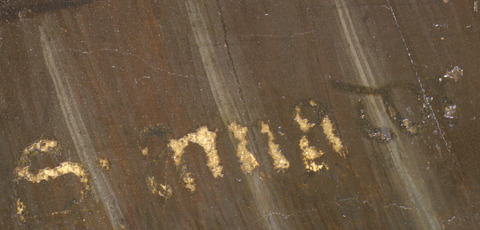
Item 2. Inscription on the shield of St. Michael: “__ migl”
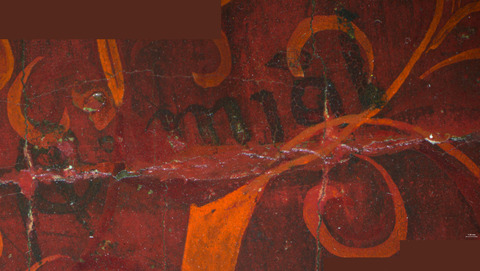
Back:
Item 3. Paper label, top horizontal cradle member, upper-left corner: “15861A/ 35 ¼ xv6” (tech. fig. 3)
Item 4. Paper label, top horizontal cradle member, upper-left corner: “T.R. #/ 10078B” (tech. fig. 3)1
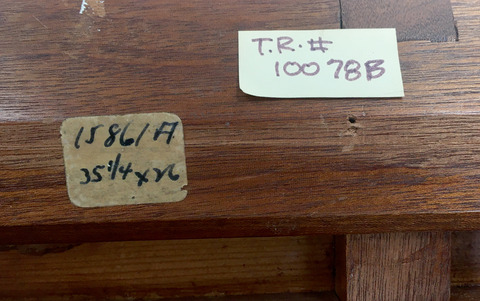
Item 5. Paper label, top horizontal cradle member, upper-right corner: “6814/2”
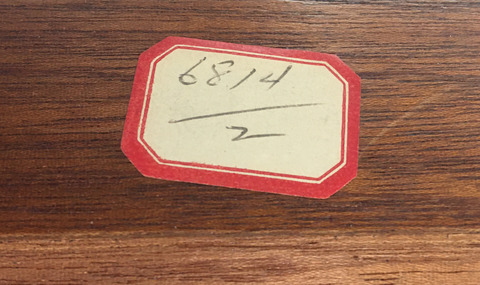
Item 6. Inscription in white paint, second from the bottom horizontal cradle member, right side: “2014.83.1”
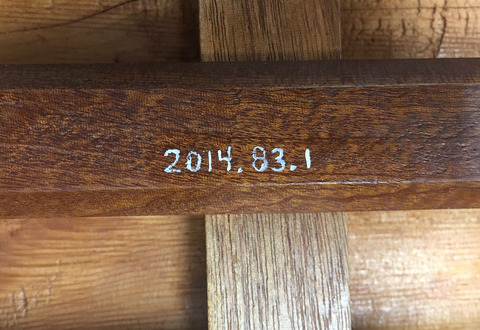
St. Stephen and St. Mary Magdalene
Front:
None
Back:
Item 7. Paper label, top horizontal cradle member, upper-left corner: “15861B/ 35 ¼ xv6” (tech. fig. 6)
Item 8. Paper label, top horizontal cradle member, upper-left corner: “T.R. #/ 10078A” (tech. fig. 6)2
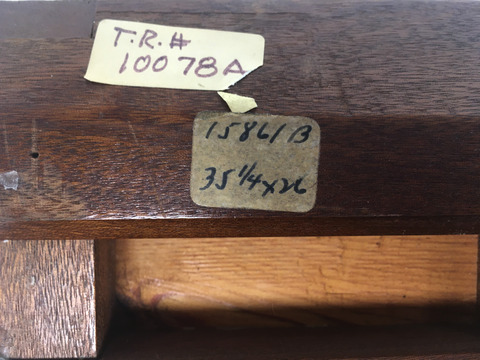
Item 9. Paper label, top horizontal cradle member, upper-right corner: “6814/3” (tech. fig. 7)
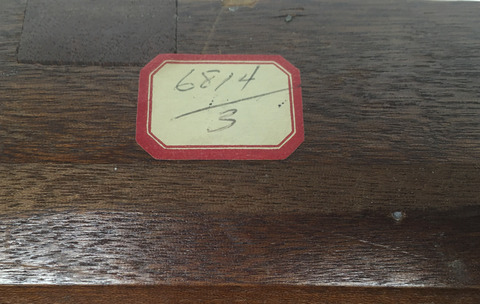
Item 10. Inscription in white paint, second from the bottom horizontal cradle member, right side: “2014.83.2”
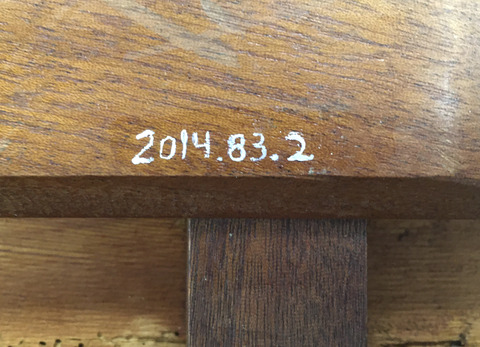
Summary of Treatment History
The paintings have been radically altered from their original construction as part of the predella (banco in Spanish) of a large altarpiece. The altarpiece was subsequently dismantled, and the panels later divided into individual vignettes. A cradle was added to the back of the predella at some point before it cut into individual vignettes. The edges of the panels show saw marks through both the panel and cradle, confirming that the cradles were added before the panels were cut into sections. It is possible that the removal of the structural stability provided by the altarpiece left the panels unsupported and vulnerable. Modern photographs show the intact predella before it was cut into sections.
In 1963, the paintings were examined and treated by paintings conservator Louis Pomerantz. His report describes the works as having large splits running horizontally from the left to the right edges, 11-1/2 inches from the bottom.3 This corresponds to the join in the board that had evidently suffered instability. A major treatment was deemed necessary. The report describes both a structural and aesthetic treatment that included filling the instability in the support and cleaved paint with a wax-resin adhesive, locally varnishing the area with Windsor & Newton “Winton” Picture Varnish, and inpainting with acrylic resin colors.4 Cracks in the frame were treated with polyvinyl acetate emulsion adhesive.5
Before arriving at the IMA on long-term loan, in 1971, the paintings were inspected by Paul Spheeris and once again described as having “dangerous cleavage.” It was recommended that they be faced before moving.6 The cleavage was set down with hot wax when the paintings arrived at the museum.7
In 2008 St. Michael and St. Amador was defaced with pencil markings while on display. Scribbles and an “X” on a portion of the background of the panel were removed, and the surface was polished with microcrystalline wax.8
The paintings were examined as part of the Clowes Collection annual survey from 2011 to 2019.
Current Condition Summary
Despite extensive structural alterations, the paintings are in good condition for works of this age. Past instabilities having been addressed, and the panels are well supported and structurally stable. The paint layer has been spared significant abrasion, and the beautiful tempera technique can be easily appreciated. This is not to say the works have been completely spared the effects of time. The pigments in the robe of St. Stephen have become discolored, and much of the mordant gilding that was used to create the brocade pattern on his robes has been abraded. Mordant gilding on the ointment jar of Mary Magdalene has also suffered abrasion, and the vermilion pigment in her robe shows discoloration. Further, the silver leaf gilding on the armor of St. Michael has tarnished and has been retouched, leaving a muddied appearance unlike the sparkling armor that was once present.
Previous interventions remain visible on the panel, and inpainting from the 1963 treatment has begun to discolor. This is not seriously distracting but is noticeable on close inspection.
Methods of Examination, Imaging, and Analysis
| Examination/Imaging | Analysis (no sample required) | Analysis (sample required) |
|---|---|---|
Unaided eye | Dendrochronology | Microchemical analysis |
Optical microscopy | Wood identification | Fiber ID |
Incident light | Microchemical analysis | Cross-section sampling |
Raking light | Thread count analysis | Dispersed pigment sample |
Reflected/specular light | X-ray fluorescence spectroscopy (XRF) | Fourier-transform infrared spectroscopy (FTIR) |
Transmitted light | Macro X-ray fluorescence scanning (MA-XRF) | Raman microspectroscopy |
Ultraviolet-induced visible fluorescence (UV) | ||
Infrared reflectography (IRR) | Gas chromatography–mass spectrometry (GC-MS) | |
Infrared transmittography (IRT) | Scanning electron microscope-energy dispersive X-ray spectroscopy (SEM-EDS) | |
Infrared luminescence | Other: | |
X-radiography |
Technical Examination
Description of Support
Analyzed Observed
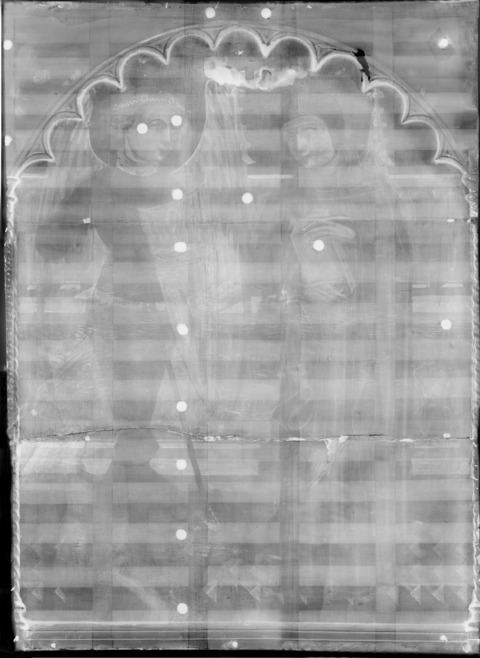
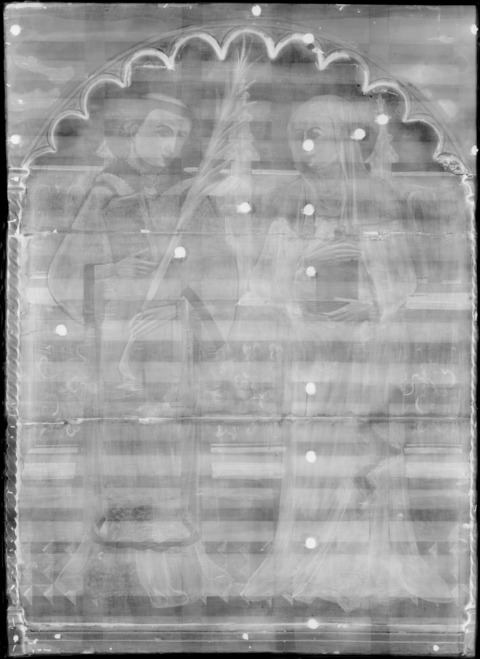
Material Type (fabric, wood, metal, dendrochronology results, fiber ID information, etc.):
Both paintings are on wood panel. Each panel is composed of three planks of wood with a horizontally oriented grain (tech. figs. 9, 10). The wood was identified by dendrochronologist Ian Tyers as Pinus sylvestris, Scots pine type.9 Pine was the predominant wood found in Castile and Aragon from the Middle Ages to the seventeenth century. In Catalonia, poplar was more commonly used.10
Characteristics of Construction/Fabrication (cusping, beveled edges of panels, seams or joins, battens):
The panels originally formed the predella of an altarpiece. It has been suggested that the predella was composed of six vignettes composed of horizontally oriented boards. The predella was later cut into the current construction, in which each vignette forms a separate panel. Both panels are constructed of three horizontally oriented planks, which vary in width from 26 to 32 cm.
The boards appear to have been butt-joined with adhesive. However, the original panels have been thinned, which may have resulted in the loss of joining mechanisms such as dowels or nails. Round dots of X-ray-absorbent material are visible, forming vertical and diagonal lines across the X-radiographs of both panels. Many of these areas cannot be seen on the back because they obscured by the cradle, but others are visible on the back of St. Michael and St. Amador. They appear to be original nail holes that have been filled with the X-ray-absorbent ground. These dots may provide clues about the original construction of the altarpiece.
Evenly spaced, vertical battens were likely nailed to the back to support the horizontally oriented boards. Each panel shows evidence of a horizontally oriented batten that, depending on how the panels were oriented on the predella, likely formed either a “v” or a “˄” shape. These battens would have served to connect the banco to the other parts of the altarpiece. X-radiographs of other panels from the predella would be necessary to confirm whether these dots line up. Reinforcing battens were normal in Spanish altarpiece constructions of this period.11 Similar constructions have been found on other Spanish Renaissance altarpieces.12
| Panel | Bottom board (width) | Middle board (width) | Top board (width) |
|---|---|---|---|
| St. Michael and St. Amador | 29 cm | 30 cm | 30.3 cm |
| St. Stephen and St. Mary Magdalene | 32 cm | 26 cm | 31.3 cm |
Table 1: Vertical width of the boards that make up each panel
Both panels have engaged frames made of carved wood that is covered in gesso, red bole, and gilding. They were attached to the front of the panels with nails (tech. fig. 11). These nails can be identified in the X-radiograph and can be seen in cross section where the panels were cut.
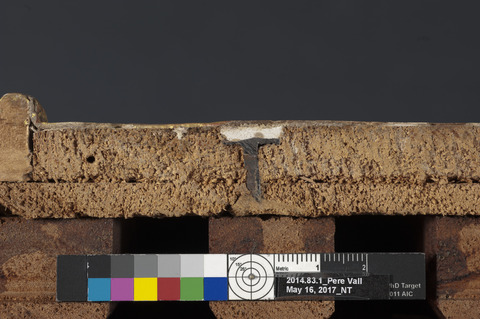
A layer of canvas was applied over the wood of each panel. This can be observed in the X-radiographs of both paintings (tech. fig. 9, 10). The canvas extends to the edges of the engaged frame on the left, right, and bottom edges and slightly onto the scalloped edge of the engaged frame at the top. In X-radiography, several small sections of canvas are visible on the top arched section of the St. Stephen and St. Mary Magdalene (tech. fig. 12).
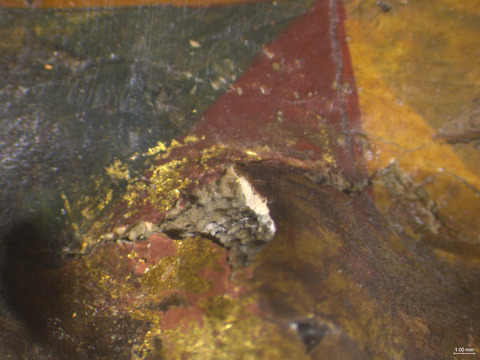
Thickness (for panels or boards):
The original panels have been thinned to approximately 1 cm. The engaged frames vary from 1 to 1.5 cm.
Production/Dealer’s Marks:
None
Auxiliary Support:
Original Not original Not able to discern None
Elaborate wooden cradles have been applied to the backs of the thinned panels. On both, the horizontal members have been glued into place and the vertical members have been designed to slide to allow the planks of wood to expand and contract vertically. The cradle construction on the two panels differs slightly. However, the designs are similar, and they were almost certainly added at the same time. The edges of the panels and cradles have been trimmed so that they are perfectly flush with the edges (tech. fig. 13), suggesting the predella was cut apart after the addition of the cradles or that the panel and cradles were trimmed after the cradles were added.

St. Michael and St. Amador
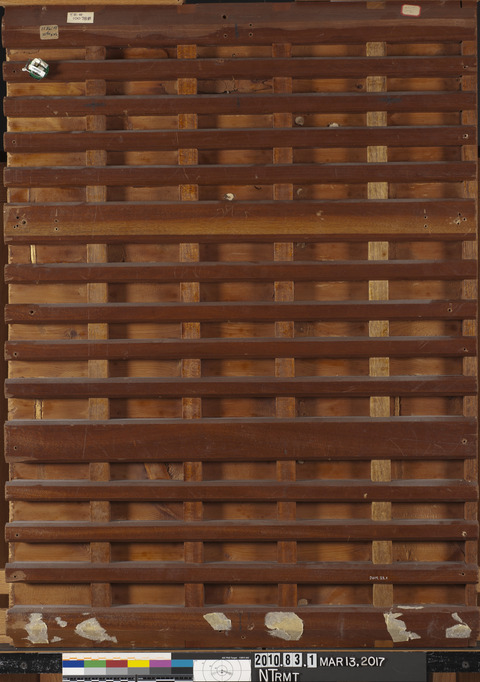
The cradle on St. Michael and St. Amador is composed of fifteen horizontal members (tech. fig. 14). The first, sixth, eleventh, and fifteenth members (from the top) are wider (5.5 cm) that the other horizontal members (2.8 cm). The sixth and eleventh members reinforce the joins in the panels. Five vertical members are 2.5 cm wide. Most of the vertical cradle members have seized and no longer slide. The ends of the cradle members are not tapered, perhaps suggesting this panel was at the center of the predella arrangement before the vignettes were separated.
St. Stephen and St. Mary Magdalene
The cradle on St. Stephen and St. Mary Magdalene is composed of fifteen horizontal members. The first, sixth, tenth, fourteenth, and fifteenth members (from the top) are wider (5.5 cm) than the other horizontal members (2.8 cm). The sixth and tenth members reinforce the joins in the panels (tech. fig. 15). Five vertical members are 2.5 cm wide. The horizontal members have been tapered at the right end, suggesting that this panel may have been at the end of the longer predella when the cradle was first applied (tech. fig. 15).
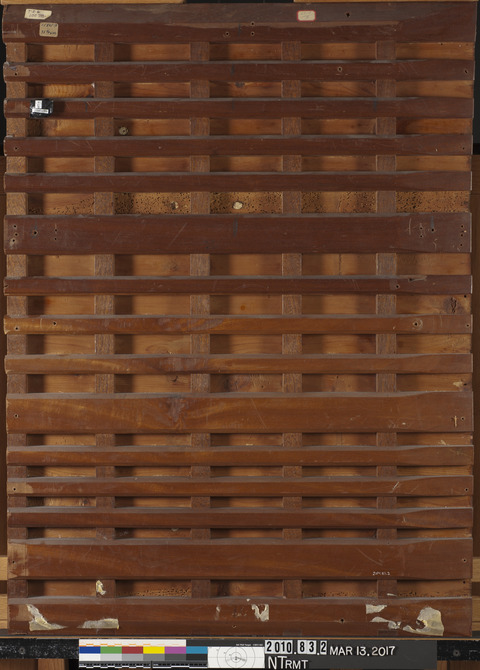
Condition of Support
The panel supports are in stable condition but have endured significant damage and alteration over time. Two areas of woodworm damage are present on the St. Stephen and St. Mary Magdalene panel. The first is located below the fifth horizontal cradle member (from the top), and the second area is located along the bottom horizontal cradle member. Both panels exhibit two large cracks in the support that correspond to joins in the boards. The cracking is particularly severe along the lower join, where accompanying paint loss has resulted in a large damage. This damage was repaired when the panels first arrived at the IMA on long-term loan.13
The panels were thinned, likely when the cradles were added. After the addition of the cradle, the edges of the panels were cut with what appears to have been a modern power tool. The cradles have been trimmed flush with the original panels and engaged frames. In several areas, the original nails that were used to adhere the engaged frame to the panel were sawn through and appear in cross section. St. Michael and St. Amador was trimmed on the right and left sides through the center of the decorative pillar elements of the engaged frame. St. Stephen and St. Mary Magdalene was trimmed on the right side only, dividing the pillar element of the engaged frame but leaving the decorative pillar on the left side intact.
On the right edge, the engaged frame of St. Michael and St. Amador has a small repair. This section may have been chipped during the sawing of the panels.
Description of Ground
Analyzed Observed
Materials/Binding Medium:
A ground layer was applied over the structure of the panel support and engaged frame. This layer can be seen filling the nail holes where the frame was nailed to the panels. The grounds on both panels are composed of calcium sulfate (gypsum). The grounds are highly water sensitive and were likely bound with glue. This ground composition was standard on both Italian and Spanish paintings of the medieval period.14
Color:
The ground is bright white (tech. figs. 25, 40, 45).
Application:
The ground appears to have been applied in a single layer. The visible light and electron micrograph images show no differentiation of texture or particle size throughout the ground sample. This suggests the ground was applied in a single layer of the same material. However, it should be noted that the ground is quite thick, and cross sections have not sampled the entire ground structure.
Thickness:
The ground is relatively thick, although perhaps not as thick as many early Italian paintings, which typically have a thick gesso grosso layer followed by a gesso sottile layer. The ground on the cross-section samples measures approximately 150–200 µm, although these samples may not include the entire thickness of the ground.
Sizing:
A size layer is not visible on the cross sections taken from either painting. This may be a result of the samples not containing the bottom of the ground.
Character and Appearance (Does texture of support remain detectable/prominent?):
The texture of the ground is smooth and is not visible through the layers of paint.
Condition of Ground
The ground is in generally good condition. The panels have an overall craquelure, which is consistent with their age. Previous losses and areas of lifting have been repaired and are stable. Losses to the paint layer and ground are present along the joins in the boards, especially along the bottom joins on both panels where structural instability caused damage to the paint layer. These areas have been adequately filled and inpainted. There are several areas of raised deformation, such as in the cloak of Mary Magdalene, that are stable but uneven.
Description of Composition Planning
Methods of Analysis:
Surface observation (unaided or with magnification)
Infrared reflectography (IRR)
X-radiography15
Analysis Parameters:
| X-ray equipment | GE Inspection Technologies Type: ERESCO 200MFR 3.1, Tube S/N: MIR 201E 58-2812, EN 12543: 1.0mm, Filter: 0.8mm Be + 2mm Al |
|---|---|
| KV: | 26 |
| mA: | 3 |
| Exposure time (s) | 180 |
| Distance from X-ray tube: | 36 |
| IRR equipment and wavelength | Opus Instruments Osiris A1 infrared camera with InGaAs array detector operating at a wavelength of 0.9-1.7µm. |
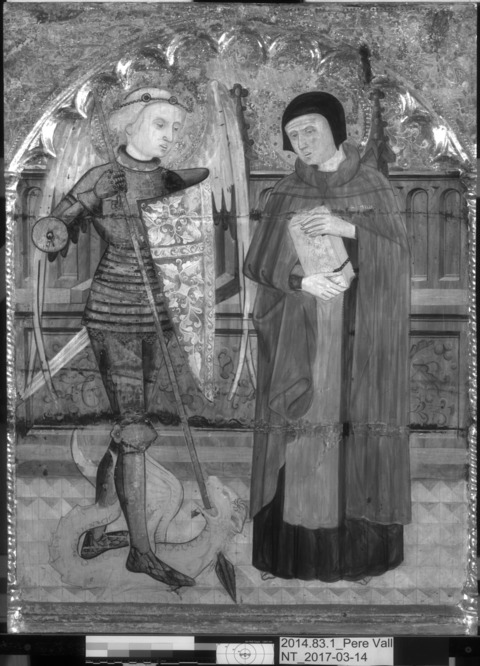
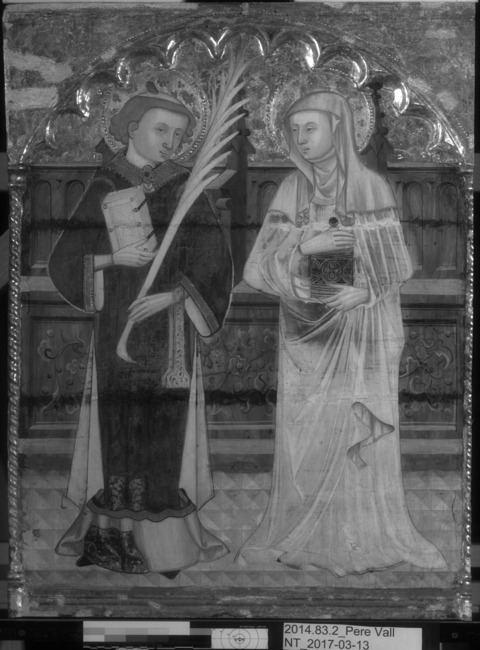
Medium/Technique:
Infrared reflectography does not show evidence of a carbon-based underdrawing (tech. figs. 16, 17); however, other evidence suggests the compositions were carefully planned prior to painting. This process was almost certainly carried out in a workshop, where different assistants were responsible for various aspects of the painting process.
Incision lines:
The fifteenth-century workshop was composed of many members with varying tasks, and contracts occasionally stipulated the role of the master in the creation of an altarpiece.16 Incision lines may have been carried out by a member of the workshop who was responsible for establishing the composition. The panels may then have been handed off to the workshop’s gilder, who, with the incision lines as a guide, would apply the bole and water gilding.
Incision lines are visible in many areas of both panels. As is typically the case, incision lines were applied before the application of water gilding to demarcate those areas from ones that were to be painted. Incision lines can be seen on St. Michael’s collar under microscopy (tech. fig. 18).
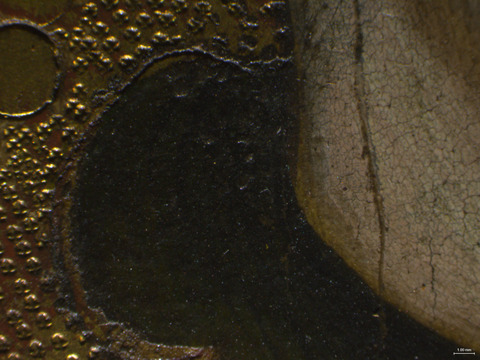
St. Stephen’s collar and chin are also outlined with incision lines. This is particularly evident when viewed in raking light (tech. fig. 19).
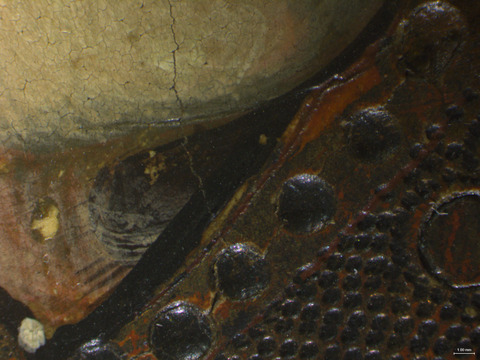
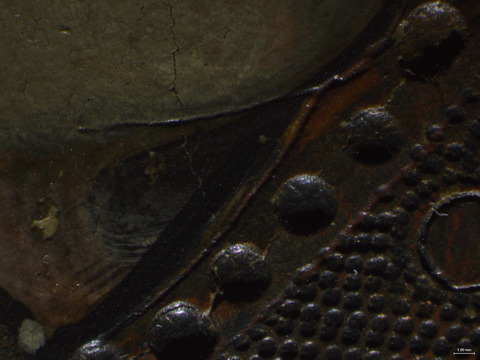
Incision lines also appear to have been used as a means of establishing the composition before painting, even in areas where water gilding is not present.17 These lines were not particularly precise but served to demarcate areas of the composition and roughly outline the contours of the figures.18 Although not ubiquitous, they can be seen outlining the figure of St. Mary Magdalene (tech. fig. 20) and in the robe of St. Amador where they demarcate folds in the drapery (tech. fig. 21).
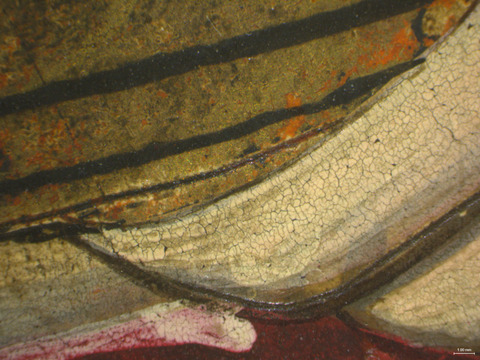
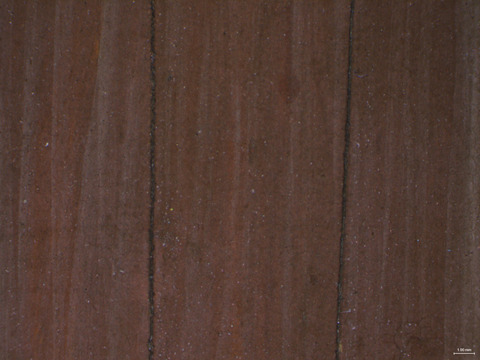
On the St. Michael and St. Amador panel, incision lines are visible on both the eyelid and ear of the dragon (tech. fig. 22). The painter appears to have slightly diverged from the original composition, placing the dragon’s ear in a slightly different position than originally outlined. Another example of a similar change is the book held by St. Amador, which was originally positioned at a different angle (tech. fig. 23). Additionally, incision lines can be found in the tiled pattern of the ground plane, where they appear to have been used to guide the perspective.
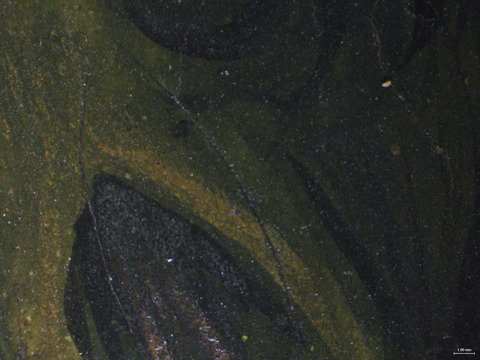

Description of Paint
Analyzed Observed
Application and Technique:
Water gilding
In the areas of the background, engaged frame, and decorative brocades, a bright red bole was applied to both panels following the contours outlined by the incision lines. Water gilding was then applied over the bole by reactivating the glue binder with “gilder’s liquor”—water with the addition of some alcohol. The gilding was left to dry and then burnished. Decorative punchwork was applied in the halos and background using a range of tools, including a compass, freehand incisions (tech. fig 24), and punches. The gilding would likely have been carried out on the entire predella at the same time, probably by a specialty gilder or team of gilders in the workshop.
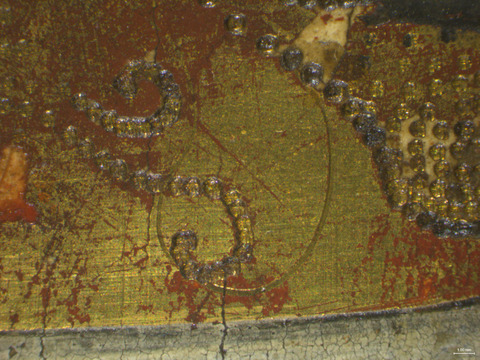
Silver leaf was identified on the armor of St. Michael (table 2, samples 1, 2, 4, 5 and 17).19 Cross section 5 from the armor shows the ground layer (tech. fig. 25, layer 1), covered with a layer of clay bole rich in iron and aluminosilicates (tech. fig. 25, layer 2). Over the bole, a layer of silver leaf (tech. fig. 25, layer 3) was applied. A copper-containing glaze layer is present over the silver leaf (tech. fig. 25, layer 4).
A BSE image of the cross section shows the distribution of iron (tech. fig. 26, orange) and aluminum (tech. fig. 27, light purple) in the bole layer, silver leaf (tech. fig. 26, dark purple), and copper-containing glaze (tech. fig. 26, green). Due to tarnishing of the silver leaf, as well as abrasion and restoration, the intended appearance of St. Michael’s armor is difficult to determine with certainty. It is possible that a green glaze was applied selectively over the silver leaf as a means of creating shadows. It is also possible that the copper glaze was applied across the entire area of silver as an intended aesthetic effect and to slow oxidation.
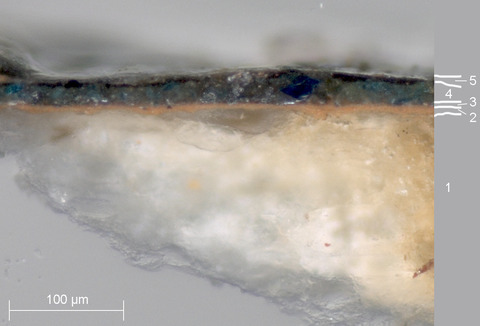
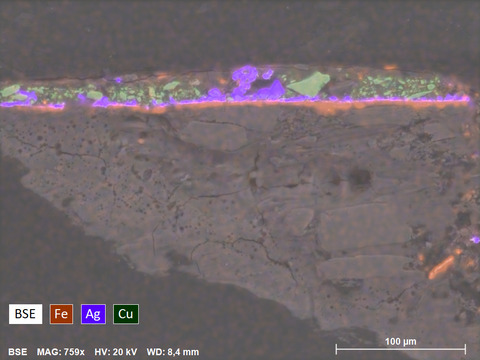
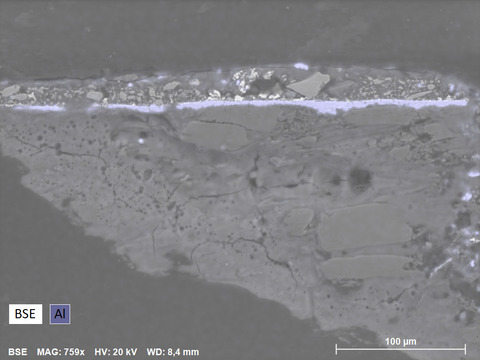
Silver and gold were detected in an XRF spectrum from the handle of St. Michael’s spear (table 2, samples 4, 5). The aim of this effect is unclear. This area is not applied over an area of gold background, so it likely was intentional and may indicate the application of white gold leaf with a component of silver. It is also possible that silver and gold leaf were carefully applied to create highlights and shadows on the spear. Macro XRF scanning could be helpful in deciphering the intended appearance of this area.
Punchwork
Four distinct punches can be identified on the panels. Three appear on both panels and two are found only on the St. Stephen and St. Mary Magdalene panel.
-
Punch 1
-
Description: Circular punch with an empty center
-
Size: 5 mm diameter
-
Locations: St. Michael and St. Amador, St. Stephen and St. Mary Magdalene
-
Usage: This punch is used in the saints' halos and in St. Stephen’s brocade. It is mostly applied in groups to make larger flower shapes (tech. fig. 28) or triplets (tech. fig. 29). The inconsistent positioning of the circles is evidence that these patterns were created from a single circular punch.
Technical Figure 28: Photomicrograph of punch 1 in the halo. Pere Vall, St. Stephen and St. Mary Magdalene, about 1410, Indianapolis Museum of Art at Newfields, The Clowes Collection, 2014.83.2.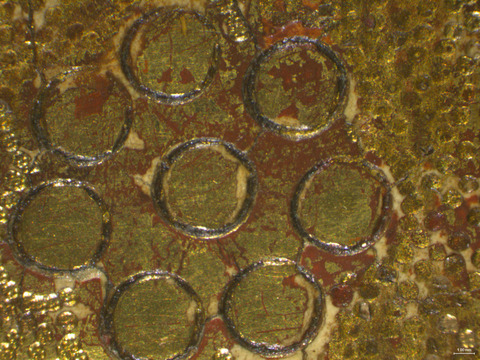 Technical Figure 28: Photomicrograph of punch 1 in the halo. Pere Vall, St. Stephen and St. Mary Magdalene, about 1410, Indianapolis Museum of Art at Newfields, The Clowes Collection, 2014.83.2.Technical Figure 29: Photomicrograph of punch 1 on collar of St. Stephen. Pere Vall, St. Stephen and St. Mary Magdalene, about 1410, Indianapolis Museum of Art at Newfields, The Clowes Collection, 2014.83.2.
Technical Figure 28: Photomicrograph of punch 1 in the halo. Pere Vall, St. Stephen and St. Mary Magdalene, about 1410, Indianapolis Museum of Art at Newfields, The Clowes Collection, 2014.83.2.Technical Figure 29: Photomicrograph of punch 1 on collar of St. Stephen. Pere Vall, St. Stephen and St. Mary Magdalene, about 1410, Indianapolis Museum of Art at Newfields, The Clowes Collection, 2014.83.2.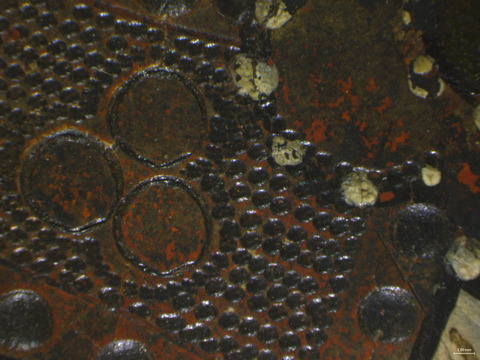 Technical Figure 29: Photomicrograph of punch 1 on collar of St. Stephen. Pere Vall, St. Stephen and St. Mary Magdalene, about 1410, Indianapolis Museum of Art at Newfields, The Clowes Collection, 2014.83.2.
Technical Figure 29: Photomicrograph of punch 1 on collar of St. Stephen. Pere Vall, St. Stephen and St. Mary Magdalene, about 1410, Indianapolis Museum of Art at Newfields, The Clowes Collection, 2014.83.2.
-
-
Punch 2
-
Description: Concave dot with a cross in the center
-
Size: 1 mm diameter
-
Locations: St. Michael and St. Amador, St. Stephen and St. Mary Magdalene
-
Usage: This punch is used in a variety of ways to create decorative patterns in the background. The tiny crosses at the center of the punch, only visible when using microscopy (tech. fig. 30), would have reflected the light of the church candles, creating a glittering effect. The punch was used to fill sections of the halos around the other punches and create a textured background of tiny, glittering dots (tech. fig. 31). This punch was also used to create organic, vine-like shapes that were designed using freehand incisions into the gilding followed by the repeated application of this punch (tech. fig. 24). This punch is particularly evident on the halos of St. Michael and St. Amador, but it is also present on the halos of St. Stephen and St. Mary Magdalene. It is used to fill in areas of the brocade on St. Stephen’s robe (tech. fig. 32). On the St. Stephen and St. Mary Magdalene panel, however, a different version of the punch may have been used, as the cross shape is less distinct. It is also possible that the punch had become slightly dull.
Technical Figure 30: Photomicrograph of punch 2 showing the tiny cross in the center. Pere Vall, St. Stephen and St. Mary Magdalene, about 1410, Indianapolis Museum of Art at Newfields, The Clowes Collection, 2014.83.2.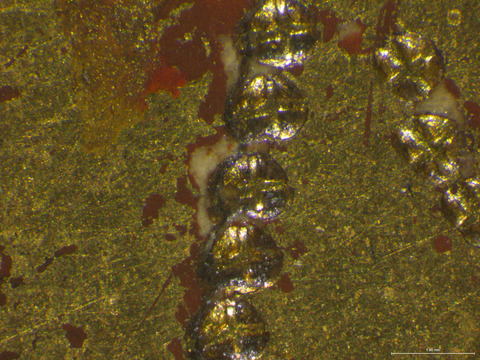 Technical Figure 30: Photomicrograph of punch 2 showing the tiny cross in the center. Pere Vall, St. Stephen and St. Mary Magdalene, about 1410, Indianapolis Museum of Art at Newfields, The Clowes Collection, 2014.83.2.Technical Figure 31: Photomicrograph of punch 2 in the background of the halo. Pere Vall, St. Stephen and St. Mary Magdalene, about 1410, Indianapolis Museum of Art at Newfields, The Clowes Collection, 2014.83.2.
Technical Figure 30: Photomicrograph of punch 2 showing the tiny cross in the center. Pere Vall, St. Stephen and St. Mary Magdalene, about 1410, Indianapolis Museum of Art at Newfields, The Clowes Collection, 2014.83.2.Technical Figure 31: Photomicrograph of punch 2 in the background of the halo. Pere Vall, St. Stephen and St. Mary Magdalene, about 1410, Indianapolis Museum of Art at Newfields, The Clowes Collection, 2014.83.2.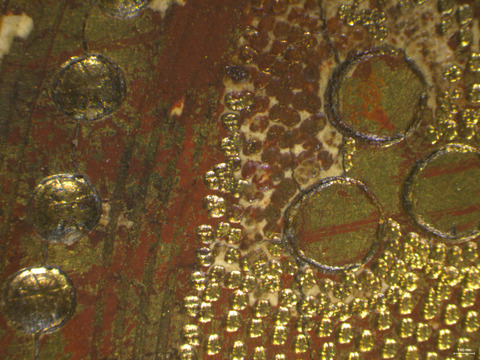 Technical Figure 31: Photomicrograph of punch 2 in the background of the halo. Pere Vall, St. Stephen and St. Mary Magdalene, about 1410, Indianapolis Museum of Art at Newfields, The Clowes Collection, 2014.83.2.Technical Figure 32: Photomicrograph of punch 2 used to fill in areas of the brocade on St. Stephen’s robe. Pere Vall, St. Stephen and St. Mary Magdalene, about 1410, Indianapolis Museum of Art at Newfields, The Clowes Collection, 2014.83.2.
Technical Figure 31: Photomicrograph of punch 2 in the background of the halo. Pere Vall, St. Stephen and St. Mary Magdalene, about 1410, Indianapolis Museum of Art at Newfields, The Clowes Collection, 2014.83.2.Technical Figure 32: Photomicrograph of punch 2 used to fill in areas of the brocade on St. Stephen’s robe. Pere Vall, St. Stephen and St. Mary Magdalene, about 1410, Indianapolis Museum of Art at Newfields, The Clowes Collection, 2014.83.2.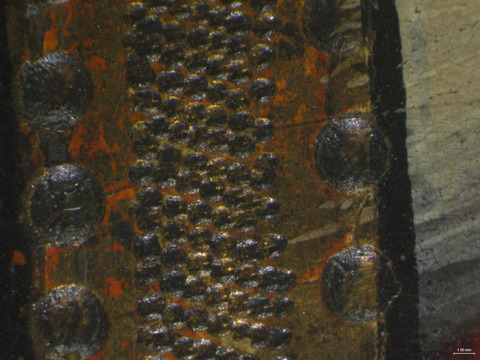 Technical Figure 32: Photomicrograph of punch 2 used to fill in areas of the brocade on St. Stephen’s robe. Pere Vall, St. Stephen and St. Mary Magdalene, about 1410, Indianapolis Museum of Art at Newfields, The Clowes Collection, 2014.83.2.
Technical Figure 32: Photomicrograph of punch 2 used to fill in areas of the brocade on St. Stephen’s robe. Pere Vall, St. Stephen and St. Mary Magdalene, about 1410, Indianapolis Museum of Art at Newfields, The Clowes Collection, 2014.83.2.
-
-
Punch 3
-
Description: Concave dot with a star shape in the center
-
Size: 3 mm diameter
-
Locations: St. Michael and St. Amador, St. Stephen and St. Mary Magdalene
-
Usage: This punch is used to create designs in the halos (tech. fig. 33) and brocade. It is slightly larger than punch 2. This punch is used to outline the halos on all four saints and along the arch of the engaged frames. Although primarily used to created a single dot, it was also used in the background to create a triplet shape.
Technical Figure 33: Photomicrograph of punch 3 in the halo. Pere Vall, St. Stephen and St. Mary Magdalene, about 1410, Indianapolis Museum of Art at Newfields, The Clowes Collection, 2014.83.2. Technical Figure 33: Photomicrograph of punch 3 in the halo. Pere Vall, St. Stephen and St. Mary Magdalene, about 1410, Indianapolis Museum of Art at Newfields, The Clowes Collection, 2014.83.2.
Technical Figure 33: Photomicrograph of punch 3 in the halo. Pere Vall, St. Stephen and St. Mary Magdalene, about 1410, Indianapolis Museum of Art at Newfields, The Clowes Collection, 2014.83.2.
-
-
Punch 4
-
Description: Star punch composed of eight triangles
-
Size: 2.5 mm across
-
Locations: St. Stephen and St. Mary Magdalene
-
Usage: This punch is used on the decorative brocade at the bottom of St. Stephen’s robe (tech. fig. 34). It appears to be a single star-shaped punch that has been applied repeatedly rather than a single triangle punch that was applied eight times to form a flower shape (tech. fig. 35), although the pressure that was applied to the punch was not always consistent.
Technical Figure 34: Photomicrograph of punch 4 on St. Stephen’s robe. Pere Vall, St. Stephen and St. Mary Magdalene, about 1410, Indianapolis Museum of Art at Newfields, The Clowes Collection, 2014.83.2.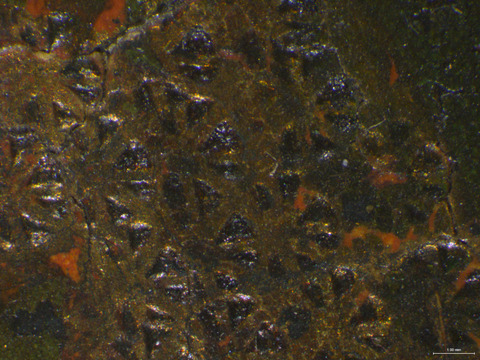 Technical Figure 34: Photomicrograph of punch 4 on St. Stephen’s robe. Pere Vall, St. Stephen and St. Mary Magdalene, about 1410, Indianapolis Museum of Art at Newfields, The Clowes Collection, 2014.83.2.Technical Figure 35: Photomicrograph of punch 4 under the green glaze on St. Stephen’s robe. Pere Vall, St. Stephen and St. Mary Magdalene, about 1410, Indianapolis Museum of Art at Newfields, The Clowes Collection, 2014.83.2.
Technical Figure 34: Photomicrograph of punch 4 on St. Stephen’s robe. Pere Vall, St. Stephen and St. Mary Magdalene, about 1410, Indianapolis Museum of Art at Newfields, The Clowes Collection, 2014.83.2.Technical Figure 35: Photomicrograph of punch 4 under the green glaze on St. Stephen’s robe. Pere Vall, St. Stephen and St. Mary Magdalene, about 1410, Indianapolis Museum of Art at Newfields, The Clowes Collection, 2014.83.2.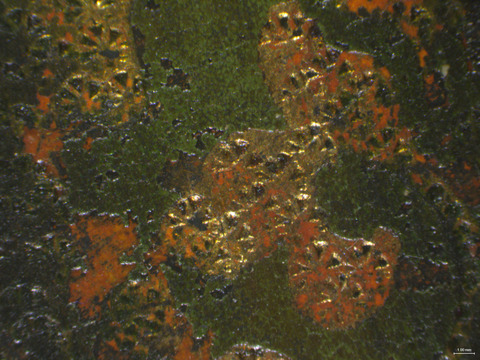 Technical Figure 35: Photomicrograph of punch 4 under the green glaze on St. Stephen’s robe. Pere Vall, St. Stephen and St. Mary Magdalene, about 1410, Indianapolis Museum of Art at Newfields, The Clowes Collection, 2014.83.2.
Technical Figure 35: Photomicrograph of punch 4 under the green glaze on St. Stephen’s robe. Pere Vall, St. Stephen and St. Mary Magdalene, about 1410, Indianapolis Museum of Art at Newfields, The Clowes Collection, 2014.83.2.
-
Paint layer
After the composition was established and water gilding had been applied to the designated areas with gold and silver leaf, the panel was likely returned to the members of the workshop responsible for painting the altarpiece.
The middle ground, which depicts a stone bench with decorative carving, and foreground, composed of a tile-patterned ground plane, were blocked in first. The gray midtone was applied to cover the entire strip of bench, and the tile pattern was blocked in using alternating triangles of color. These areas were likely painted across all the vignettes on the predella at the same time, leaving reserves for the figures, which were probably outlined in an underdrawing medium (not able to be detected in IRR) and/or using incision lines. Evidence of this reserve can still be observed along the edges of St. Stephen and Mary Magdalene’s robes (tech. fig. 36).
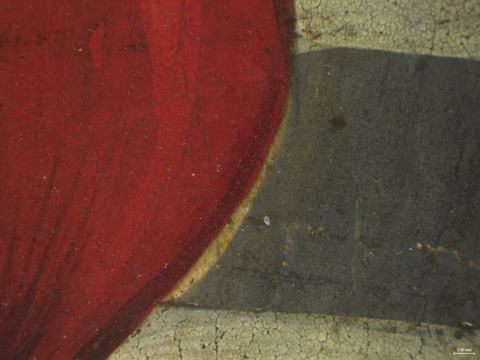
The robes, shield, dragon, books, and wings were blocked in next, starting with a midtone layer that was applied evenly to the areas left in reserve. Upon applying these paint layers, the artist left a rough reserve for the hands and faces of the saints, which were painted after the robes (tech. fig. 37).
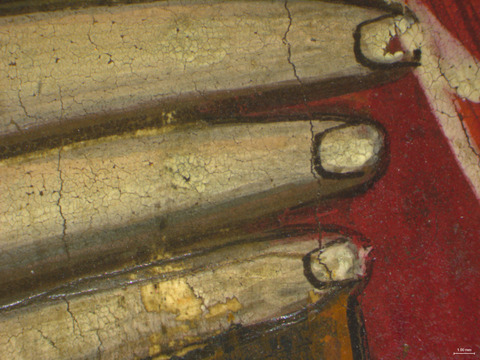
In the robes of St. Mary Magdalene and St. Amador, shadows and highlights were applied over the midtone layer in deliberate, linear strokes to create the illusion of form. On the robes of St. Amador, a brown color was used for the midtone. The highlights were painted in what appears to be an almost pure white, applied in small strokes over the underlying brown midtone (tech. fig. 38). Shadows were applied using black paint, also in hatched, linear brushstrokes. In the robe of Mary Magdalene, a dark red, possibly red lake pigment, was used for the shadows, while a brighter red, vermilion, was used for the midtones and highlights (tech. fig. 39).
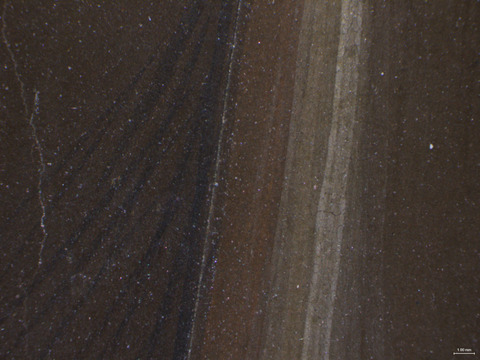
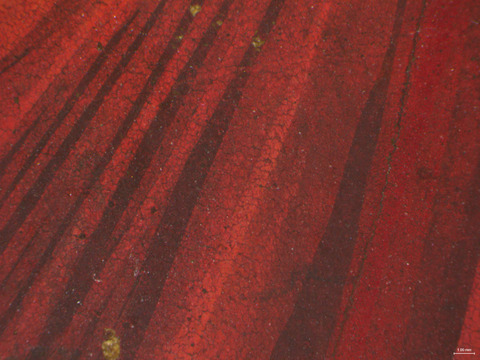
A cross section from Mary Magdalene’s robe shows the application of a thick layer of pure vermilion, as is illustrated by the distribution of mercury (tech. fig. 41, red) and sulfur (tech. fig. 42, green) in the EDS distribution maps. A thin, dark red glaze (tech. fig. 40, layer 3) is visible over the layer of vermilion (tech. fig. 40, layer 2) and under the varnish (tech. fig. 40, layer 4). This layer is likely a red lake pigment, and some aluminum appears to be present in this area, but further analysis is necessary to confirm the presence of red lake pigments.
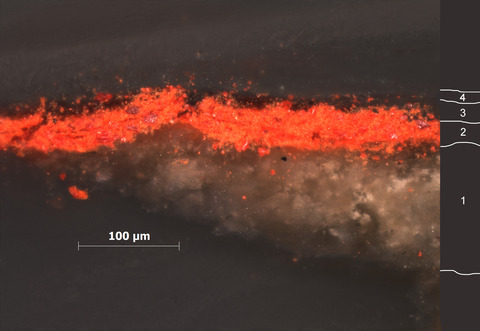
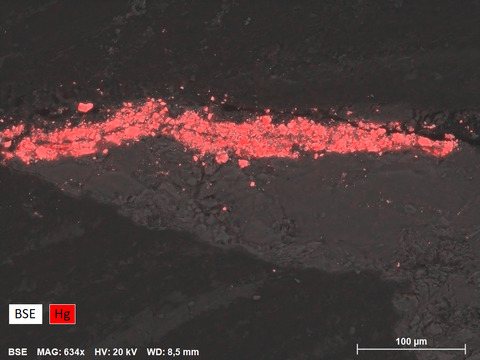
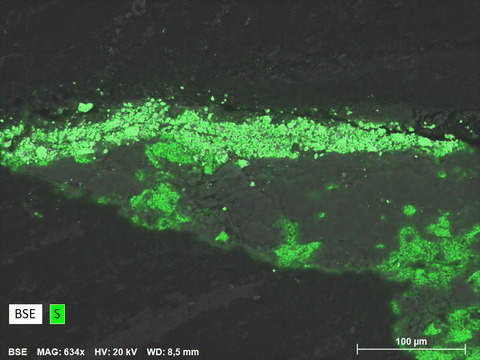
In Mary Magdalene’s white veil, warm and cool tones were manipulated to create subtle undulations in the drapery. Shadows were applied using cool gray, white mixed with some black, while the midtones and highlights were applied using warmer tones of white (tech. fig. 43). In some areas, such as St. Michael’s wings, St. Stephen’s martyr’s palm, and the body of the dragon, several mixtures of paint were used to create a gradient from one area of color to another. In the dragon, the bright green midtone transitions into dark green areas of shadow. The green is mixed with a higher proportion of yellow in areas of highlights.
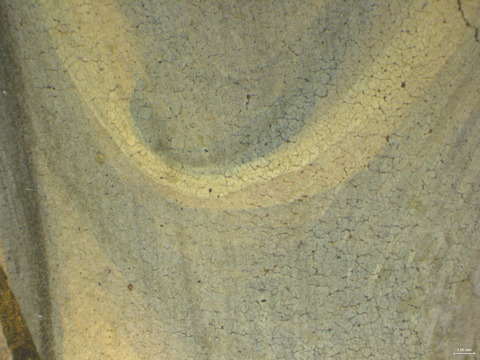
In St. Michael’s wings, mixtures of different proportions of what appear to be red lake pigments and white20 were carefully applied to each segment to create the effect of feathers with a light to dark gradation of color. A similar gradient technique was used on the cuffs and red lining of St. Stephen’s robe, where linear hatching is employed to transition from deep red to a cooler pink (tech. fig. 44).
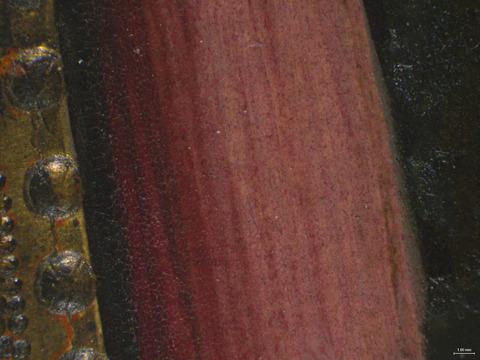
St. Stephen’s robe was painted using an elaborate technique that would have had a stunning optical effect; however, degradation and damage has caused the once remarkable appearance to become muddled. Cross section 7 from St. Stephen’s robe (tech. fig. 45, layer 2) shows a gray underlayer that appears to be a mixture of lead white and carbon black pigment (tech. fig. 46, blue). This layer was likely used to block in the form. Over the gray layer is a one of copper-containing blue pigments (azurite) (tech. fig. 47, green). A thin layer of natural ultramarine blue particles was applied to the surface over the thick layer of azurite and can be detected in SEM/EDS by the presence of sodium (tech. fig. 47, orange). The presence of a thin scumbling of natural ultramarine particles was confirmed by Raman microspectroscopy on the surface of the cross section. This layer structure conforms to the description by Felipe Nunes of how to paint in tempera with the infrequently used pigment ultramarine. Although Nunes was writing in 1615, several centuries after the Clowes panels were created, he instructs the reader to first work up the drapery with Castile blue (azurite) and then apply the ultramarine thinly, because “it does not cover well since it is a color of little body."21
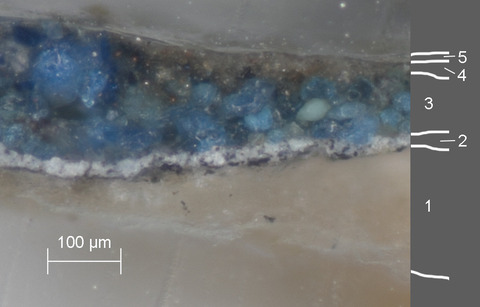
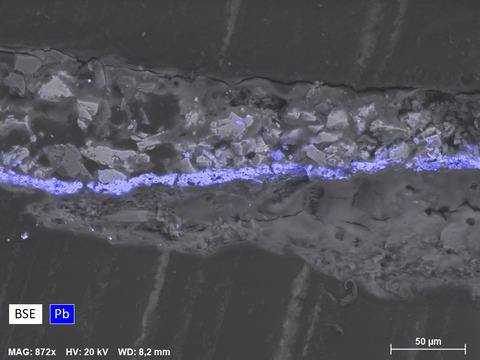

The value of ultramarine blue was noted in some Catalonian contracts for retables. In a contract from the Convent of San Augustín in Zaragoza, the use of ultramarine blue (referred to as Acre blue) was specified for use in the banco and the area immediately above it; thus, the most valuable pigment was used for the area that the congregation could see most closely.22 Overall, the use of ultramarine in fifteenth-century Spanish panels is rare. Even when it was specified in a contract, artists appear to have used it in a layered structure, applying the valuable ultramarine economically over an existing layer of azurite, as on the robes of St. Stephen.23
Over the layers of blue, a decorative brocade pattern was applied using mordant gilding. Although severely abraded, remnants of this design are still visible (tech. fig. 48). Incision lines in the robe indicate the undulating drapery and may have been emphasized by the mordant brocade pattern. Evidence of a change during painting can be seen on St. Stephen’s cuff. The water gilding and punchwork extend below the area where his sleeve now ends. To shorten the length of the sleeve, the background paint (gray) was extended over the water gilding (tech. fig. 49).
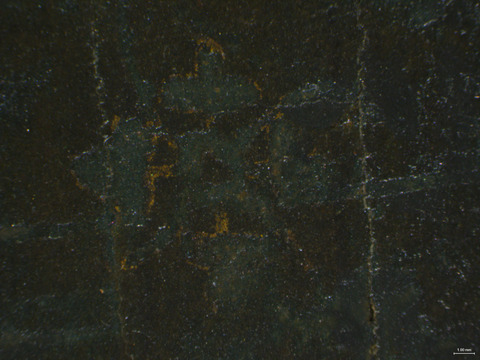
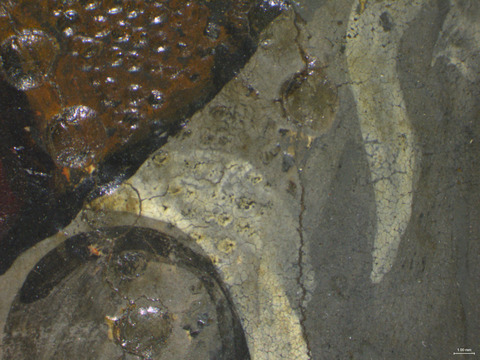

The faces of the figures were painted to fill the reserves that were left during the painting of the robes. The technique in the face is quite distinct; the artist created form through the widespread manipulation of the turbid medium effect to create cool transition shadows. Much as green verdaccio layers were used to create areas of shadow in Italian painting of the same period, the painter here employed a warm gray underlayer in areas of shadow, such as around the eyes, lips, and noses. Strokes of thin beige paint were applied over the gray underlayer, exploiting the turbid medium effect to create cool shadows where the beige paint is thinnest. The warm gray paint is left exposed in the deepest shadows, creating a delicate transition from warm to cool shadows, and finally to midtones and highlights (tech. figs. 50).

The use of the turbid medium effect is also evident in the forehead of St. Amador where deep wrinkles were painted in dark gray and covered with small stokes of white and beige paint (tech. fig. 51).
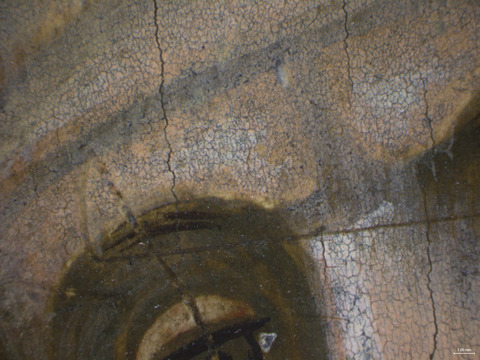
Pinks were used around the eyelids as well as on the lips (tech. fig. 52) and cheeks to bring life to the otherwise pale faces of the saints (tech. fig. 53).The hands were painted following a similar technique in which the dimensionality of each finger was created by transition from warm gray shadows to bright white highlights (tech. fig. 54).

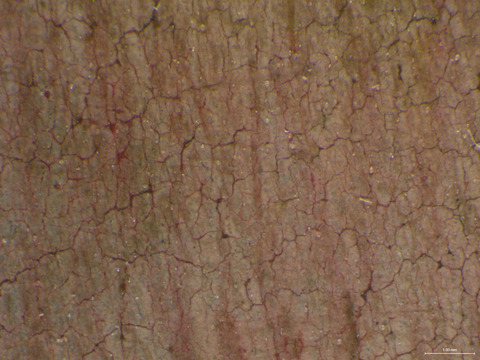
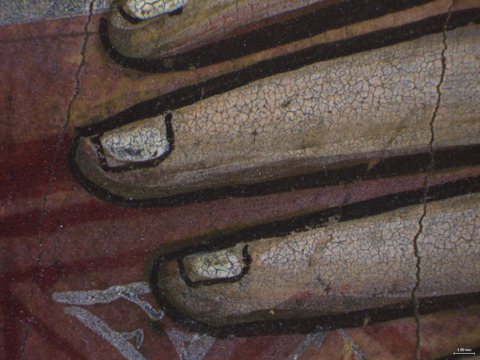
The toes of St. Amador peek out unassumingly from under his robe. His proper left foot seems to have six toes (tech. fig. 55) and his proper right foot only four (tech. fig. 56). The toes were painted by first outlining the form of the foot in a warm gray shadow. Form was then created through the application of dabs of pure white highlights on the nails and knuckles of the toes.
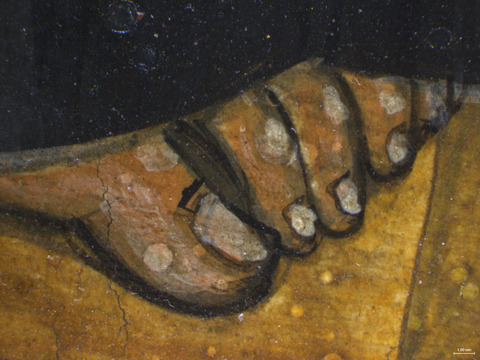
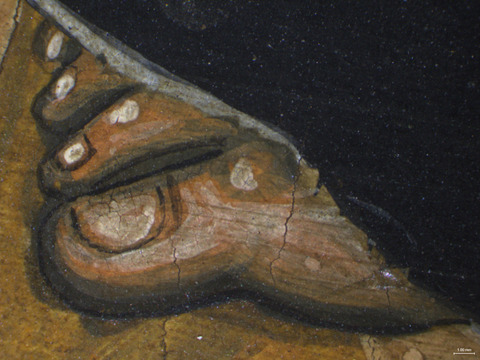
Bold outlining in a dark black paint, which varies in thickness, was applied as a final stage of the painting process to define the contours of the robes, hair, and facial features. Black outlining was also used to provide detailing to the stone bench, attributes, and fingernails (tech. fig. 54). This graphic outlining provides a stylistic unity to the figure and vignettes across the predella.
Mordant gilding
Mordant gilding is present in several areas of the panels. To create mordant gliding, detailing was painted in an oil mordant and, after it was dry to the touch but still tacky, shell gold was sprinkled over it. As discussed above, St. Stephen’s elaborate brocade robe was created using mordant gliding designs (tech. fig. 48). The edge of Mary Magdalene’s veil was also gilded in this fashion (tech. fig. 57; table 3, sample 14). Gold was also detected in XRF analysis of St. Michael and St. Amador in a line coming out the ear of the dragon and the “St. Amador” inscription (table 2, samples 28, 29).

Painting Tools:
A variety of tools were used to create these highly decorative panels. Materials for applying water gilding would have included medium to large brushes for applying bole and gilder’s liquor, hair brushes for lifting and applying gilding, tools for burnishing the gilding, and decorative punches for creating patterns in the gold.
The paint was applied primarily in small, deliberate brushstrokes with small and medium-sized brushes.
Binding Media:
The binding medium from two samples from the St. Stephen and St. Mary Magdalene panel were analyzed using FTIR. As was typical in medieval Catalonian painting, egg yolk was confirmed as the binding media in samples taken from St. Stephen’s skin and from St. Stephen’s blue robe.24 Analysis revealed the binding media used to paint the green glaze on St. Stephen’s robe to be a mixture of egg yolk with a higher proportion of an oil.25 This suggests the predella was painted in egg tempera with the addition of oil media in some areas.26
Color Palette:
As was typical of artists working on the Iberian peninsula in the late fourteenth and early fifteenth centuries, a bright, varied pigment palette was used on the predella.27 In fact, Spanish painters infrequently used earth tones, as they were considered “lower colors."28 XRF, Raman microspectroscopy, and SEM-EDS analyses were used to confirm the presence of a range of pigments in addition to both gold and silver leaf.
The use of several red pigments, including vermilion, red lead, and iron oxide (red earth pigments), was confirmed. Additionally, visual observation suggests the use of red lake pigments. XRF analysis of red passages, such as the robe of Mary Magdalene and the shield of St. Michael, detected strong peaks for mercury. In the shadows of the robe and shield, strong peaks for mercury with minimal peaks for lead (tech. fig. 58; table 3, sample 18; table 2, sample 13) were found.29 These areas were painted with nearly pure vermilion, as confirmed in cross section 4 from the robe of Mary Magdalene that shows a thick layer of pure vermilion (tech. fig. 41). The reddish-orange detailing on St. Michael’s shield was painted using red lead, as confirmed with Raman microspectroscopy. Analysis of red areas in the floor tiles detected strong peaks for iron with no peak for mercury. This suggests the muted red tones were painted using iron oxide red earth pigments. A sample from the wing of St. Michael shows large particles of a translucent red pigment that appears to be a red lake pigment. Analysis using SEM-EDS was unable to identify the substrate of this organic pigment.
The presence of blue pigments azurite, indigo, and natural ultramarine were confirmed using Raman microspectroscopy. A multilayered structure, consisting of a thick layer of azurite followed by a thin scumbling of ultramarine, was identified in St. Stephen’s robe. A sample from the blue robe confirmed the presence of azurite with both FTIR and Raman microspectroscopy. Ultramarine was confirmed using Raman microspectroscopy.
In the green dragon and green floor tiles, however, strong peaks for copper were not detected using XRF. Arsenic was detected in these areas, suggesting a mixture of indigo and arsenic-containing yellow (orpiment) pigments to create these green passages (tech. fig. 58; table 2, sample 15). Both orpiment and indigo were confirmed in a sample from the green dragon using Raman microspectroscopy. This combination of orpiment and indigo, referred to as vergaut, was used by medieval painters as an alternative to the copper-containing green pigment verdigris.30 However, orpiment was rarely used in panel paintings, perhaps due to its poisonous nature, which was already recognized in the fifteenth century.31 In the area of green glaze at the bottom of St. Stephen’s robe, XRF analysis revealed a strong peak for copper and no peak for arsenic (tech. fig. 59; table 3, sample 5). Raman microspectroscopy suggested the presence of a copper resinate (or oleate) in this area. Copper-containing green also appears as a glaze over the silver leaf on St. Michael’s armor (tech. fig. 25) and may also have been used in the maniple draped over on St. Stephen’s arm (tech. fig. 59; table 3, sample 11).
In addition to orpiment, lead-tin yellow and yellow ocher appear to have been used to paint yellow passages of the panels. Orpiment appears to have been used primarily in the green mixtures and was not detected in areas of pure yellow. XRF analysis suggests the precise application of lead-tin yellow in areas of yellow highlights, such as those on St. Stephen’s martyr’s palm (tech. figs. 58, 59; table 2, sample 10; table 3, sample 9), while yellow ocher was used to paint darker yellow areas such as the orange area of St. Michael’s hair, the orange floor tiles, and the shadow of the martyr’s palm (tech. figs. 58, 59; table 2, samples 9, 18; table 3, sample 10). In these areas, strong peaks for iron are present but peaks for tin and arsenic are absent.
In addition to yellow ocher and red earth, iron oxide earth pigments were widely used in areas of brown, such as the robe of St. Amador (tech. fig. 58; table 2, samples 23, 24). Blacks and grays were likely painted with carbon black pigments with the addition of lead white, although this was not conclusively confirmed with analysis.
XRF Analysis:
St. Michael and St. Amador
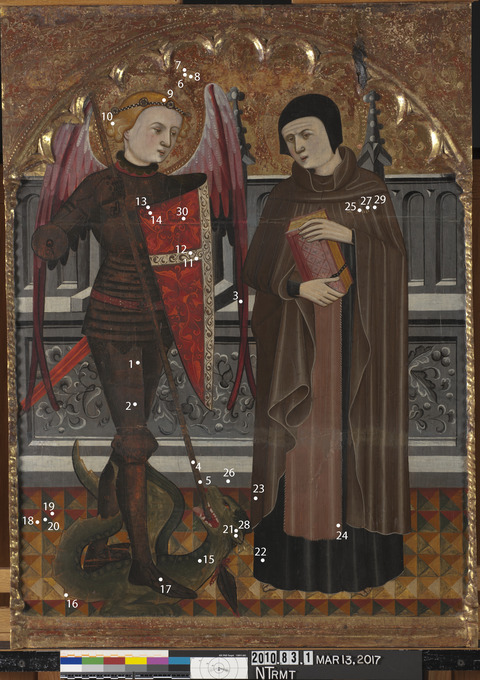
| Sample | Location | Elements | Possible Pigments |
|---|---|---|---|
| 1 | Armor | Major: Fe, Sr Minor: Ag, Pb, Ca Trace: Cu, Ti, Mn | Silver leaf, lead white, iron oxide (earth pigments including umber from the bole and possibly retouching), calcium and strontium (from ground layer), trace of copper-containing green and/or blue pigment. |
| 2 | Armor 2 | Major: Ca, Fe, Pb, Sr Minor: Ag Trace: Cu, Ti, Mn | Silver leaf, lead white, iron oxide (earth pigments including umber from the bole and possibly retouching), calcium and strontium (from ground layer), trace of copper-containing green and/or blue pigment. |
| 3 | Wing (dark pink) | Major: Pb Minor: Fe, Ca Trace: | Red lake (not detectable using XRF), lead white, iron oxide (earth pigments including umber from the bole), calcium (from ground layer), trace of copper- containing green and/or blue pigment. |
| 4 | St. Michael’s Spear | Major: Au, Fe, Sr Minor: Ag, Pb Trace: Cu, Ti, Mn | Silver leaf, gold leaf, lead white, iron oxide (earth pigments including umber from the bole), calcium and strontium (from ground layer), trace of copper- containing green and/or blue pigment. |
| 5 | St. Michael’s Spear 2 | Major: Au, Pb, Ca Minor: Ag, Fe, Sr Trace: Cu, Ti | Silver leaf, gold leaf, lead white, calcium and strontium (from ground layer), iron oxide (earth pigments including umber from the bole), trace of copper-containing green and/or blue pigment. |
| 6 | Ground layer | Major: Ca Minor: Sr Trace: Pb, Fe | Calcium-containing ground layer with quantity of strontium, trace of iron oxide (earth pigments), trace of lead white. |
| 7 | Bole layer | Major: Ca, Fe Minor: Sr Trace: Pb | Iron oxide rich bole, calcium and strontium (from ground layer), trace of lead white. |
| 8 | Gilding | Major: Au, Fe Minor: Ca, Sr, Pb Trace: K, Mn, Ti, Cu | Gold leaf, iron oxide rich bole, calcium and strontium (from ground layer), lead white. |
| 9 | Orange hair | Major: Pb, Fe Minor: Ca, Sr, Zn Trace: | Iron oxide (earth pigments, likely yellow ocher), lead white, calcium and strontium (from ground layer), zinc white (likely from traces of retouching). |
| 10 | Yellow hair highlight | Major: Pb, Fe Minor: Ca, Sr, Sn Trace: | Iron oxide (earth pigments, likely yellow ocher), lead white, lead-tin yellow, calcium and strontium (from ground layer). |
| 11 | White area of shield | Major: Pb Minor: Au, Ag, Fe, As Trace: Ca, Sr, Cu | Gold leaf, silver leaf, lead white, iron oxide (earth pigments), orpiment, calcium and strontium (from ground layer), trace of copper-containing green and/or blue pigment. |
| 12 | Design of white area of shield | Major: Pb Minor: Trace: Ca, Sr, Cu | lead white, calcium and strontium (from ground layer), trace of iron oxide (earth pigments), trace of copper-containing green and/or blue pigment. |
| 13 | Dark red shield | Major: Hg Minor: Ca, Sr Trace: Pb, Fe | Vermilion, calcium and strontium (from ground layer), trace of iron oxide (earth pigments), trace of lead white, possible red lake pigment (not detectable using XRF). |
| 14 | Bright red shield | Major: Hg, Pb Minor: Ca, Sr Trace: Fe | Vermilion, lead white, calcium and strontium (from ground layer), trace of iron oxide (earth pigments). |
| 15 | Dark green on dragon | Major: Ca, Pb, As Minor: Cu, Sr, Fe Trace: K, Ti | Vergaut (orpiment and indigo confirmed with Raman microspectroscopy), copper-containing green and/or blue pigment, iron oxide earth pigment (possibly terre verde), calcium and strontium (from ground layer). |
| 16 | Orange highlight on dragon | Major: Ca, Pb, As Minor: Cu, Sr, Fe Trace: K, Ti, Zn | Orpiment, vergaut (orpiment and indigo confirmed with Raman microspectroscopy), copper-containing green and/or blue pigment, iron oxide earth pigment. |
| 17 | St. Michael’s foot | Major: Fe, Sr Minor: Ag, Pb, Cu Trace: Ti, Mn | Silver leaf, lead white, iron oxide (earth pigments, including umber from the bole and possibly retouching), calcium and strontium (from ground layer), copper-containing green and/or blue pigment. |
| 18 | Orange floor tile | Major: Fe, Pb Minor: Ca Trace: Cu, Sr, Zn | Iron oxide (earth pigments), lead white, calcium and strontium (from ground layer), small trace of copper- containing green and/or blue pigment. |
| 19 | Red floor tile | Major: Fe, Pb Minor: Ca, Sr Trace: Cu, K, Ti, As, Zn | Iron oxide (earth pigments), lead white, calcium and strontium (from ground layer), small trace of copper- containing green and/or blue pigment, trace of orpiment. |
| 20 | Green floor tile | Major: Pb Minor: Ca, As Sr, Fe Trace: Cu, K, Zn | Vergaut (orpiment and indigo), lead white, iron oxide earth pigment, calcium and strontium (from ground layer), small trace of copper-containing green and/or blue pigment. |
| 21 | Abraded area on line from dragon’s ear | Major: Ca, Pb Minor: As Trace: Ti, Cu, Zn | Lead white, calcium (from ground layer), iron oxide (earth pigments), orpiment, small trace of copper- containing green and/or blue pigment. |
| 22 | Black cloak | Major: Pb Minor: Ca, Sr Trace: Fe, Cu | Lead white, calcium and strontium (from ground), trace of iron oxide (earth pigments), likely carbon black (not detectable with XRF). |
| 23 | Dark brown cloak | Major: Pb, Fe Minor: Ca, Sr, Zn Trace: Cu | Iron oxide (earth pigments), lead white, calcium and strontium (from ground layer), small trace of copper- containing green and/or blue pigment. |
| 24 | Light brown cloak | Major: Pb, Fe Minor: Ca Trace: Cu, Sr | Lead white, iron oxide (earth pigments), calcium and strontium (from ground layer), small trace of copper- containing green and/or blue pigment. |
| 25 | Abraded “M” on St. Amador inscription | Major: Ca Minor: Pb, Sr, Fe Trace: Cu | Calcium and strontium (from ground layer), lead white, iron oxide (earth pigments), small trace of copper-containing green and/or blue pigment. |
| 26 | Gray bench | Major: Pb Minor: Ca, Sr Trace: Fe Cu | Lead white, likely carbon black (not detectable with XRF), small trace of iron oxide (earth pigments), calcium and strontium (from ground layer), small trace of copper-containing green and/or blue pigment. |
| 27 | “A” on St. Amador inscription | Major: Pb, Minor: Fe, Cu Ca, Sr, As Trace: Ti, K, Zn | Lead white, iron oxide (earth pigments), copper-containing green and/or blue pigment, orpiment, calcium and strontium (from ground layer). |
| 28 | Line from dragon’s ear | Major: Ca, Pb, As Minor: Au, Fe, Sr, Fe Trace: Cu, K, Ti, Zn | Gold leaf, lead white, calcium and strontium (from ground layer), vergaut (orpiment and indigo), iron oxide earth pigment, small trace of copper-containing green and/or blue pigment. |
| 29 | “R” on St. Amador inscription | Major: Pb Minor: Fe, Au, Ca, Sr Trace: As, Ag, Cu, Ti, Zn | Gold leaf, lead white, iron oxide (earth pigments), calcium and strontium (from ground layer), trace of copper-containing green and/or blue pigment, trace of orpiment, trace of silver leaf. |
| 30 | St. Michael inscription | Major: Hg Minor: Trace: Ca, Sr, Pb, Fe | Vermilion, carbon-containing black pigment (not detectable using XRF), trace of lead white, trace of calcium and strontium (from ground layer), trace of iron oxide (earth pigments). |
Table 2: Results of X-ray fluorescence analysis conducted with a Bruker Artax microfocus XRF with rhodium tube, silicon-drift detector, and polycapillary focusing lens (~100μm spot).
*Major, minor, trace quantities are based on XRF signal strength not quantitative analysis
St. Stephen and St. Mary Magdalene
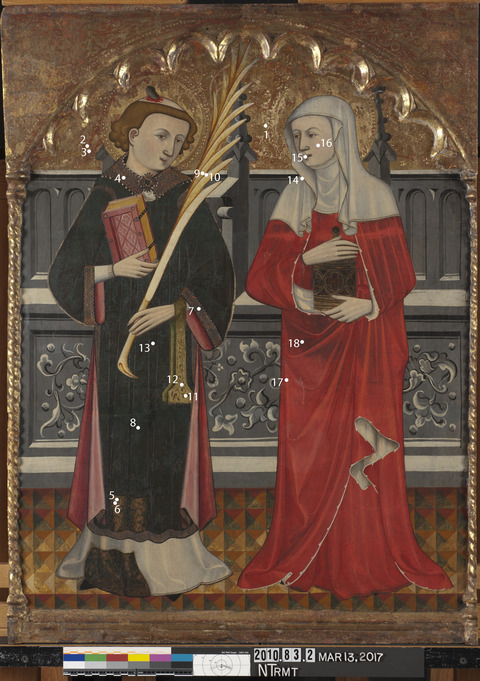
| Sample | Location | Elements | Possible Pigments |
|---|---|---|---|
| 1 | Ground layer | Major: Ca Minor: Sr Trace: Pb, Fe, Cu | Calcium-containing ground layer with quantity of strontium, trace of iron oxide (earth pigments), trace of lead white, trace of copper-containing green and/or blue pigment. |
| 2 | Bole layer | Major: Ca, Fe Minor: Sr Trace: Pb, Zn, Mn, Ti, K, Au | Iron oxide rich bole, calcium and strontium (from ground layer), trace of lead white, trace of gold leaf. |
| 3 | Gilding | Major: Au, Fe Minor: Ca, Sr Trace: K, Mn, Ti, Cu | Gold leaf, iron oxide rich bole, calcium and strontium (from ground layer), trace of copper-containing green and/or blue pigment. |
| 4 | St. Stephen’s collar | Major: Fe, Au, Ca Minor: Ag, Sr Trace: K, Mn, Ti, Cu | Gold leaf, silver leaf, iron oxide rich bole, calcium and strontium (from ground layer), trace of copper-containing green and/or blue pigment. |
| 5 | Green glaze on St. Stephen’s robe | Major: Cu, Pb Minor: Trace: Au, Fe, Ca, Sr | Copper-containing green pigment, lead white, trace of gold leaf, trace of iron oxide rich bole, calcium (from ground layer). |
| 6 | Black interstices of punchwork on the bottom of St. Stephen’s robe | Major: Cu, Pb Minor: Ag, Au, Ca, Sr, Fe Trace: | Copper-containing green pigment, lead white, silver leaf, gold leaf, trace of iron oxide rich bole, calcium (from ground layer). |
| 7 | Black interstices of punchwork on the sleeve of St. Stephen’s robe | Major: Cu, Pb Minor: Ag, Au, Ca, Sr, Fe Trace: Ti, Mn | Copper-containing green pigment, lead white, silver leaf, gold leaf, trace of iron oxide rich bole, calcium and strontium (from ground layer). |
| 8 | Blue robe | Major: Cu, Pb Minor: Ca, Fe, As Trace: Sr | Copper-containing blue and/or green pigment, lead white, iron oxide (earth pigments), orpiment, calcium and strontium (from ground layer). |
| 9 | Light yellow martyr’s palm | Major: Pb Minor: Cu, Ca, Sn Trace: Fe, Sr | Lead-tin yellow and/or lead white, copper-containing green and/or blue pigment, calcium and strontium (from ground layer), trace of iron oxide (earth pigments). |
| 10 | Dark yellow outlining martyr’s palm | Major: Fe, Pb Minor: Ca Trace: Cu, Sr, Sn | Iron oxide (earth pigments), lead white, calcium and strontium (from ground layer), trace of copper-containing green and/or blue pigment, trace of lead-tin yellow. |
| 11 | Green maniple on St. Stephen’s robe | Major: Cu, Pb Minor: Ca, Sr Trace: Fe | Copper-containing green and/or blue pigment, lead white, calcium and strontium (from ground layer), trace of iron oxide rich bole. |
| 12 | Design on green maniple | Major: Cu, Pb Minor: Au, Fe Trace: Ca, Sr | Copper-containing green and/or blue pigment, lead white, gold leaf, calcium and strontium (from ground layer), iron oxide rich bole. |
| 13 | Gold brocade on St. Stephen’s robe | Major: Cu, Pb Minor: Au, Fe, Ca Trace: Sr | Copper-containing blue pigment, lead white, gold leaf, iron oxide (earth pigments), calcium and strontium (from ground layer). |
| 14 | Border on Mary Magdalene’s veil | Major: Pb Minor: Au Trace: Fe, Ca, Sr | Lead white, gold leaf, trace of iron oxide (earth pigments), trace of calcium and strontium (from ground layer). |
| 15 | Gray shadow around Mary Magdalene’s lips | Major: Pb Minor: Fe, Ca Trace: Sr, Cu, Zn | Lead white, likely carbon black (not detectable with XRF), iron oxide (earth pigments), calcium and strontium (from ground layer), trace of copper-containing green and/or blue pigment. |
| 16 | Cheek of Mary Magdalene | Major: Pb Minor: Hg Trace: Fe, Ca, Sr | Lead white, vermilion, trace of iron oxide (earth pigments), trace of calcium and strontium (from ground layer). |
| 17 | Highlight on Mary Magdalene’s robe | Major: Hg Minor: Pb Trace: Ca, Sr, Fe | Vermilion, lead white and or red lead, trace of calcium and strontium (from ground layer), small trace of iron oxide (earth pigments). |
| 18 | Shadow on Mary Magdalene’s robe | Major: Hg Minor: Trace: Fe, Ca, Sr | Vermilion, trace of iron oxide (earth pigments), trace of calcium and strontium (from ground layer). |
Table 3: Results of X-ray fluorescence analysis conducted with a Bruker Artax microfocus XRF with rhodium tube, silicon-drift detector, and polycapillary focusing lens (~100μm spot).
*Major, minor, trace quantities are based on XRF signal strength not quantitative analysis
Surface Appearance:
The paint layers are thickly applied, obscuring the texture of the panel. There are some undulations and prominent cracks due to aging, but the surface of the paint layer is otherwise smooth.
Condition of Paint
Both paintings are generally in good condition. Loss to the paint layer has occurred on both panels, particularly along the joins in the boards. The paintings have two horizontal losses along the joins where paint loss has occurred. The upper loss goes through the chest of the saints and the lower loss across the panels at their knees. Other losses have also occurred across the panels but are small and localized. There are numerous uneven areas of paint where the surface is raised and large, disruptive cracks have formed. While previous instability in these areas is evident, the paint is currently well adhered and stable.
The mordant gilding has endured extensive damage across the panel and has been completely abraded in many areas. Damage to the water gilding is also present in the form of abrasion. This is particularly significant on the upper portions of the panels behind the heads of the figures. A large loss in this area is present on the St. Michael and St. Amador panel. A large, charred area is also present on the upper-right section of this panel, likely the result of a candle burning too close to the altarpiece.
Interestingly, warranties were sometimes included in the contracts for retables to cover issues with deterioration. A contract for a retable in the Convent of San Augustín in Zaragoza stipulated, “if anything goes bad in this work during the space of twenty years, whether the gold or the colors, the masters are obliged to repair it."32 Several patterns of degradation of the paint layer and gilding can be observed on the Clowes panels, although it is difficult to say when this deterioration occurred.
Perhaps most striking is the discoloration in the robe of St. Mary Magdalene. Once bright red, many strokes of paint there now appear black, likely the result of a phenomenon known as the “blackening of vermilion."33 The appearance of St. Stephen’s robe has also altered significantly. In addition to severe abrasion to the mordant gilding, the layer of natural ultramarine that was scumbled over the azurite has darkened, possibly a result of “ultramarine sickness."34 The silver leaf used to create St. Michael’s armor has also tarnished, creating a muddied appearance where significant retouching was applied to compensate for the confused appearance.
Minor scratches are present on both panels, including across the face of St. Amador, over the floor and the dragon, and on the robes of St. Mary Magdalene.
Description of Varnish/Surface Coating
Analyzed Observed Documented
| Type of Varnish | Application |
|---|---|
Natural resin | Spray applied |
Synthetic resin/other | Brush applied |
Multiple Layers observed | Undetermined |
No coating detected |
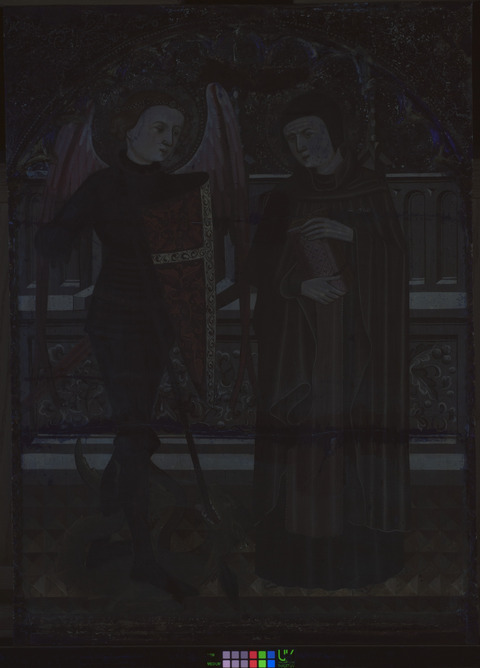
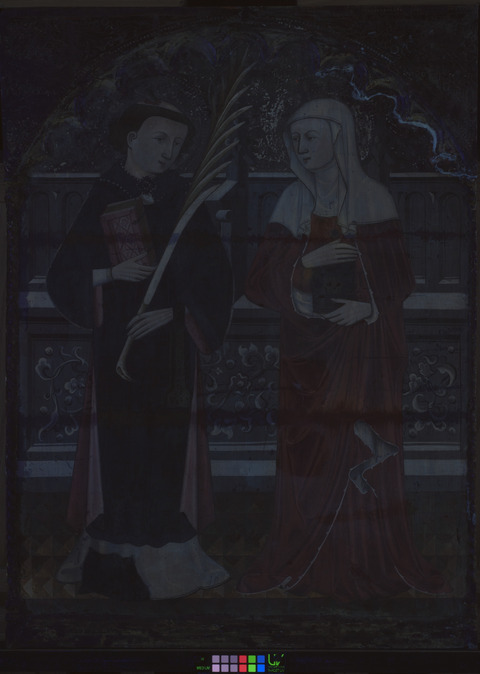
The varnish on the panels does not fluoresce strongly under ultraviolet-induced visible fluorescence (tech. figs. 60, 61). FTIR analysis confirmed the presence of a synthetic resin varnish composed of the acrylic copolymer resin ethyl acrylate/methyl methacrylate (EA/MMA). Several Paraloid resins, including Paraloid B-82 and Paraloid B-44, are EA/MMA resins.35
Inpainting, which appears dark in ultraviolet-induced visible fluorescence, is present along the joins in the panels where past structural instabilities caused paint loss. Inpainting is present over scattered losses across the panel but has been applied quite sparingly.
Condition of Varnish/Surface Coating
The varnish is in adequate condition. It has a matte appearance that has become slightly desaturated, but this is not overly distracting.
The inpainting has also become slightly desaturated. The large split through the chest of Mary Magdalene was not inpainted to mimic the folds of the robe, creating a rather distracting stripe though the figure. The inpainting along the lower join on the St. Michael and St. Amador panel has also discolored and is no longer well matched to the surrounding paint.
Description of Frame
Original/first frame (see Description of Support)
Period frame
Authenticity cannot be determined at this time/ further art historical research necessary
Reproduction frame (fabricated in the style of)
Replica frame (copy of an existing period frame)
Modern frame
Modern Frame Dimensions:
Outside frame dimensions: 92 × 69 × 7.6 cm
Sight size: 90 × 67 cm
Distinguishing Marks:
St. Michael and St. Amador
Item 11. Paper label, printed and typed: “NO. 15861 A SIZE 35 ¼ × 26/ Saint Michael and Saint Amator/ TITLE/ Pere Vall/ ARTIST/ Circa 1400”
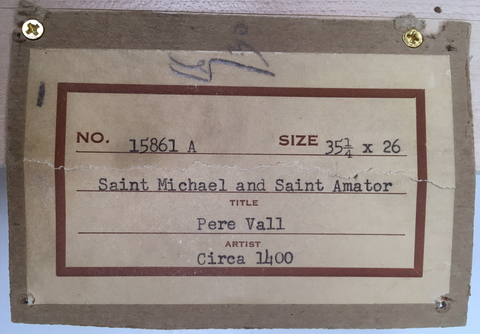
St. Stephen and St. Mary Magdalene
Item 12. Paper label, printed and typed: “NO. 15861 B SIZE 35 ¼ x 26/ Saint Esteban and the Magdalene/ TITLE/ Pere Vall/ ARTIST/ Circa 1400”
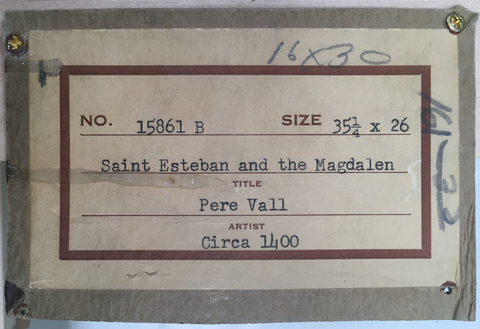
Item 13. Paper Label, printed: “NEWHOUSE GALLERIES/ INCORPORATED/ PAINTINGS/ 15 EAST 57TH ST. NEW YORK 22. N. Y.”
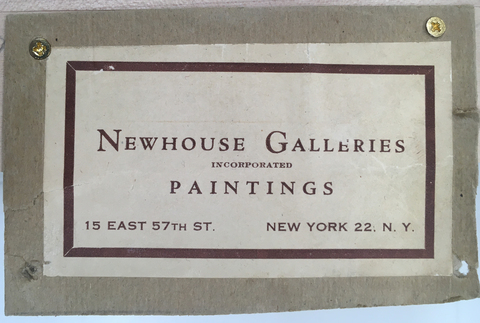
Description of Molding/Profile:
For description of the original engaged frames, see Characteristics of Construction/Fabrication.
The predella fragments have been framed in simple floating box frames. These frames were custom built for the paintings by Metropolitan Picture Framing in 2006.
Condition of Frame
The frames are in good condition.
Notes
-
The previous accession number (C#) for this object was C10078A. It is likely that this “T.R. #” was 10078A and the sticker was placed on the wrong object. ↩︎
-
The previous accession number (C#) for this object was C10078B. It is likely that this “T.R. #” was 10078B and the sticker was placed on the wrong object. ↩︎
-
Louis Pomerantz, “Preliminary Report of Condition,” February 1963, Conservation Department Files, Indianapolis Museum of Art at Newfields. ↩︎
-
Louis Pomerantz, “Preliminary Report of Condition,” February 1963, Conservation Department Files, Indianapolis Museum of Art at Newfields. ↩︎
-
Louis Pomerantz, “Treatment Report,” February 1963, Conservation Department Files, Indianapolis Museum of Art at Newfields. ↩︎
-
Memorandum from Ian Frasier to Carl J. Weinhardt, “Incoming and Temporary Receipt Memorandum of Objects Received T.R. No. 10078,” 7 November 1971, Conservation Department Files, Indianapolis Museum of Art at Newfields. Paul A.J. Spheeris, “Conservation Report on the Condition of the Clowes Collection,” 25 October 1971, Conservation Department Files, Indianapolis Museum of Art at Newfields. ↩︎
-
Martin Radecki. Condition assessment, before Oct 1973 (undated), Collection Clowes, Clowes Registration Archive, Indianapolis Museum of Art at Newfields, 22. ↩︎
-
Maureen Tucker, “Indianapolis Museum of Art Damage Report Form,” 24 June 2008, Conservation Department Files, Indianapolis Museum of Art at Newfields. ↩︎
-
Ian Tyers “Tree-ring Analysis and Wood Identification of Paintings from the Indianapolis Museum of Art,” Dendrochronological Consultancy Report 1082, unpublished report, January 2019, 32. ↩︎
-
Zahira Véliz, “Wooden Panels and Their Preparation for Painting from the Middle Ages to the Seventeenth Century in Spain,” in The Structural Conservation of Panel Paintings: Proceedings of a Symposium at the J. Paul Getty Museum, 24–28 April 1995, ed. Kathleen Dardes and Andrea Rothe (Los Angeles: Getty Conservation Institute, 1998), 137. See also Judith Berg Sobré, Behind the Altar Table: The Development of the Painted Retable in Spain, 1350–1500 (Columbia: University of Missouri Press, 1989), 51. ↩︎
-
Judith Berg Sobré, Behind the Altar Table: The Development of the Painted Retable in Spain, 1350–1500 (Columbia: University of Missouri Press, 1989), 52. ↩︎
-
Zahira Véliz, “Wooden Panels and Their Preparation for Painting from the Middle Ages to the Seventeenth Century in Spain,” in The Structural Conservation of Panel Paintings: Proceedings of a Symposium at the J. Paul Getty Museum, 24–28 April 1995, ed. Kathleen Dardes and Andrea Rothe (Los Angeles: Getty Conservation Institute, 1998), 137. See also Judith Berg Sobré, Behind the Altar Table: The Development of the Painted Retable in Spain, 1350–1500 (Columbia: University of Missouri Press, 1989), 51. See also X-radiography published in María Dolores Gayo García, Maite Jover de Celis, and Laura Alba Carcelén, “The Altarpiece of Saint Dominic of Silos by Bartolomé Bermejo: An Example of Painting Practices during the Early Spanish Renaissance,” in The Renaissance Workshop (London: Archetype Publications, 2013), 73. ↩︎
-
Louis Pomerantz, “Treatment Report,” February 1963, Conservation Department Files, Indianapolis Museum of Art at Newfields. ↩︎
-
Nati Salvadó, Salvador Butí, Francesco Ruiz Quesada, Hermann Emerich, Trinitat Pradell, “Mare de Déu dels Consellers, de Lluís Dalmau. Una nova técnica per a una obra singular,” Butlletí del Museu Nacional d’Art de Catalunya 9 (2008): 48, accessed September 1, 2020, https://www.raco.cat/index.php/ButlletiMNAC/article/view/127807/175979 ↩︎
-
Elvacite 2040 (synthetic resin) was used to fill the cradle so that its appearance would be minimized in the X-radiograph, allowing the composition to be better interpreted. ↩︎
-
Judith Berg Sobré, Behind the Altar Table: The Development of the Painted Retable in Spain, 1350–1500 (Columbia: University of Missouri Press, 1989), 19. ↩︎
-
A similar practice of using incision lines as a means of outlining the composition was noted by Sobré. She suggests the lines echo a standard cartoon used in the workshop. Judith Berg Sobré, Behind the Altar Table: The Development of the Painted Retable in Spain, 1350–1500 (Columbia: University of Missouri Press, 1989), 55. ↩︎
-
Extensive incision lines can be found on a panel by Bartolomé Bermejo dated 1474–77. While stylistically very different from the Clowes panels, these incisions function similarly. María Dolores Gayo García, Maite Jover de Celis, and Laura Alba Carcelén, “The Altarpiece of Saint Dominic of Silos by Bartolomé Bermejo: An Example of Painting Practices during the Early Spanish Renaissance,” in The Renaissance Workshop (London: Archetype Publications, 2013), 74. ↩︎
-
Silver was also used on the armor of St. Michael on a retable dedicated to the saint by the Aragonese Master of Belmonte. Care was taken to apply varnish to the silver to keep it from tarnishing. Judith Berg Sobré, Behind the Altar Table: The Development of the Painted Retable in Spain, 1350–1500 (Columbia: University of Missouri Press, 1989), 59. ↩︎
-
The presence of red lake pigments was not confirmed using analysis. However, translucent deep red particles were identified in cross section. ↩︎
-
Felipe Nunes, “Arts of Poetry, and of Painting and Symmetry, with Principles of Perspective,” in Artists’ Techniques in Golden Age Spain: Six Treatises in Translation, ed. and trans. Zahira Véliz (Cambridge: Cambridge University Press, 1987), 6. ↩︎
-
Judith Berg Sobré, Behind the Altar Table: The Development of the Painted Retable in Spain, 1350–1500 (Columbia: University of Missouri Press, 1989), 61. ↩︎
-
Judith Berg Sobré, Behind the Altar Table: The Development of the Painted Retable in Spain, 1350–1500 (Columbia: University of Missouri Press, 1989), 61. ↩︎
-
Nati Salvadó, Salvador Butí, Francesco Ruiz Quesada, Hermann Emerich, and Trinitat Pradell, “Mare de Déu dels Consellers, de Lluís Dalmau. Una nova técnica per a una obra singular,” Butlletí del Museu Nacional d’Art de Catalunya: 9 (2008): 50, accessed September 1, 2020, https://www.raco.cat/index.php/ButlletiMNAC/article/view/127807/175979. ↩︎
-
N. Salvadó et al., “Materials i tècnica en la pintura de Jaume Huguet (s. XV),” Butlletí del Museu Nacional
d’Art de Catalunya 5 (2001): 47–58. ↩︎
-
The use of oil paint was not widely used as a paint binder on the Spanish peninsula until the 1470s, although earlier documented examples do exist. Alberto Velasco Gonzàlez, “Para que sus deliberaciones y consejos no vayan herrados sino acertados. Gonzalo de la Caballería y el retablo de la capilla del Concejo de Zaragoza (1443),” Turiaso, 22 (2014–15): 316. The earliest documented use of oil as a medium comes in 1328 from the inventory of the shop of Ramon Torrent, where it appears to have been used in a limited fashion. Judith Berg Sobré, Behind the Altar Table: The Development of the Painted Retable in Spain, 1350–1500 (Columbia: University of Missouri Press, 1989), 63–64. The oldest documented use of a work painted entirely in oil is Mare de Déu dels Consellers by Lluís Dalmau, dated 1443–45. Nati Salvadó, Salvador Butí, Francesco Ruiz Quesada, Hermann Emerich, and Trinitat Pradell, “Mare de Déu dels Consellers, de Lluís Dalmau. Una nova técnica per a una obra singular,” Butlletí del Museu Nacional d’Art de Catalunya 9 (2008), accessed September 1, 2020, https://www.raco.cat/index.php/ButlletiMNAC/article/view/127807/175979. ↩︎
-
Judith Berg Sobré, Behind the Altar Table: The Development of the Painted Retable in Spain, 1350–1500 (Columbia: University of Missouri Press, 1989), 60. ↩︎
-
Ramirez de Arellano, cited in Judith Berg Sobré, Behind the Altar Table: The Development of the Painted Retable in Spain, 1350–1500 (Columbia: University of Missouri Press, 1989), 63. ↩︎
-
This is probably because mercury is acting as a filter to any lead underneath. ↩︎
-
“Vergaut,” CAMEO Conservation and Art Materials Encyclopedia Online, http://cameo.mfa.org/wiki/Vergaut. ↩︎
-
Judith Berg Sobré, Behind the Altar Table: The Development of the Painted Retable in Spain, 1350–1500 (Columbia: University of Missouri Press, 1989), 63. ↩︎
-
Quoted in Judith Berg Sobré, Behind the Altar Table: The Development of the Painted Retable in Spain, 1350–1500 (Columbia: University of Missouri Press, 1989), 46. ↩︎
-
Vermilion discoloration appears to be a result of exposure to chloride ion in the environment. Discoloration most frequently effects layers of pure vermilion, such as that of the robe of Mary Magdalene (see cross section 4, tech. fig. 40). A similar effect can be seen on Plate 5 and Plate 7a in Marika Spring and Rachel Grout,
“The Blackening of Vermilion: An Analytical Study of the Process in Paintings,” National Gallery Technical Bulletin 23 (2002): 59, https://www.nationalgallery.org.uk/upload/pdf/spring_grout2002.pdf. ↩︎
-
The surface layer (layer 4) on cross section 7 (tech. fig. 45) appears gray and pale, much like a cross section from the Vermeer painting A Young Woman standing at a Virginal, which has the same condition. Helen Howard, “Altered Appearance of Ultramarine,” The National Gallery website, accessed August 28, 2020, https://www.nationalgallery.org.uk/research/about-research/the-meaning-of-making/vermeer-and-technique/altered-appearance-of-ultramarine. ↩︎
-
“Paraloid,” CAMEO Conservation and Art Materials Encyclopedia Online, http://cameo.mfa.org/wiki/Paraloid. ↩︎
Additional Images
